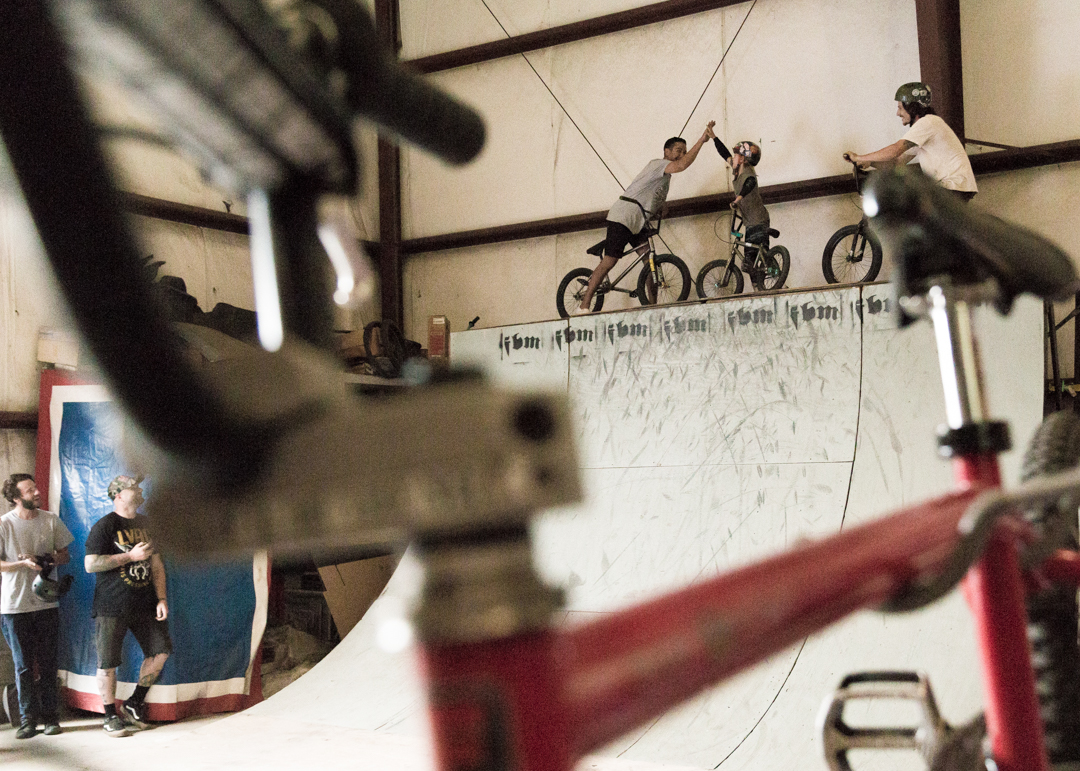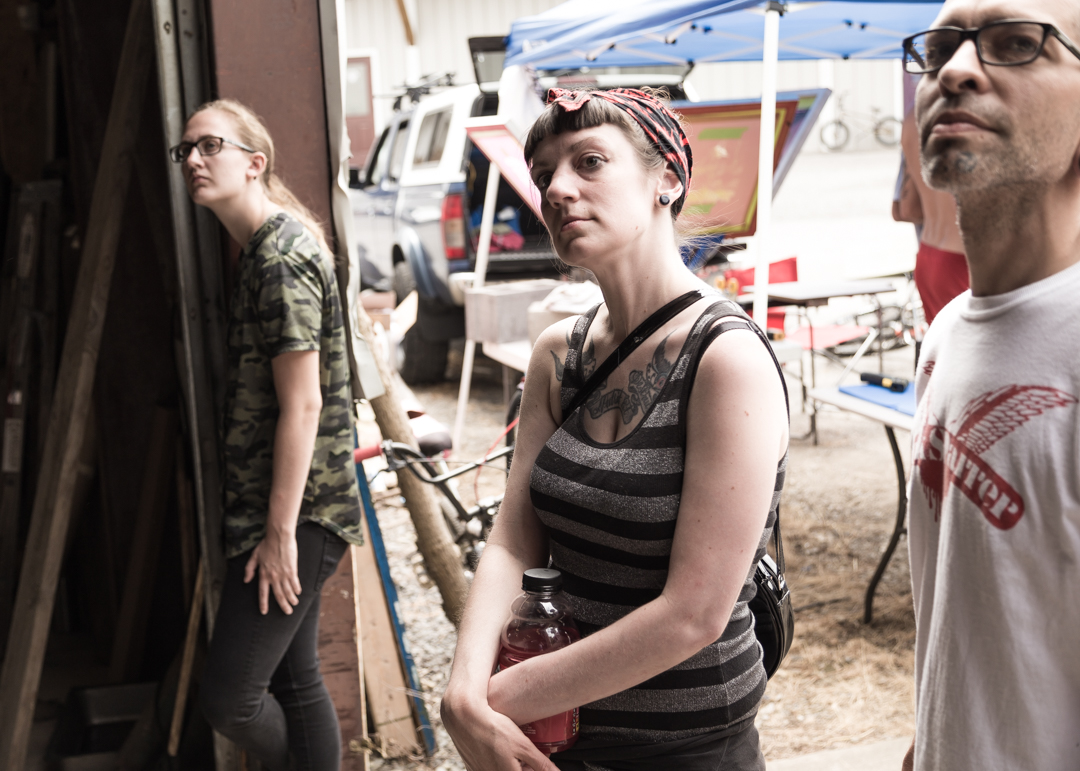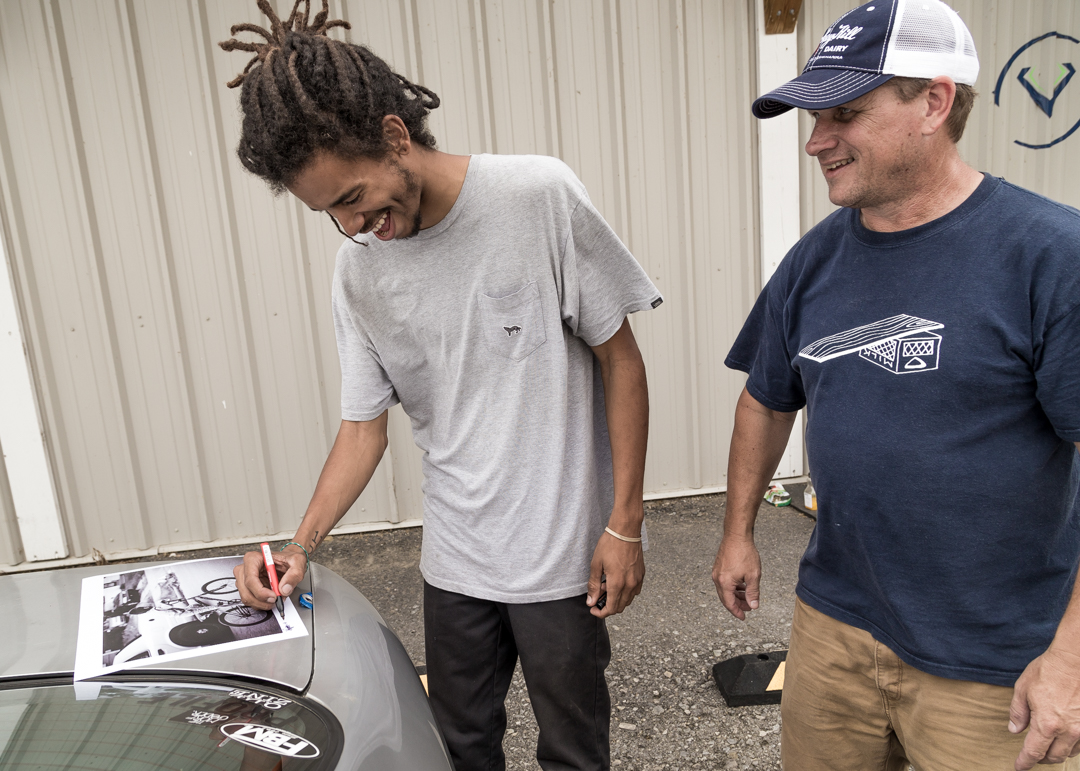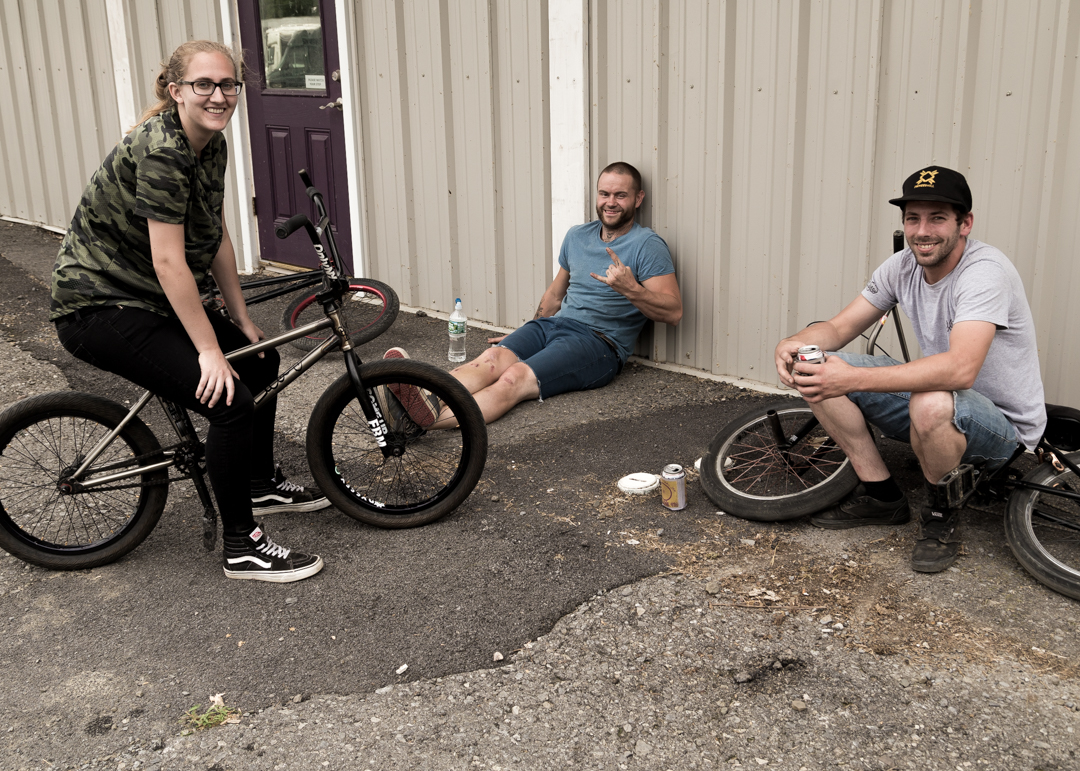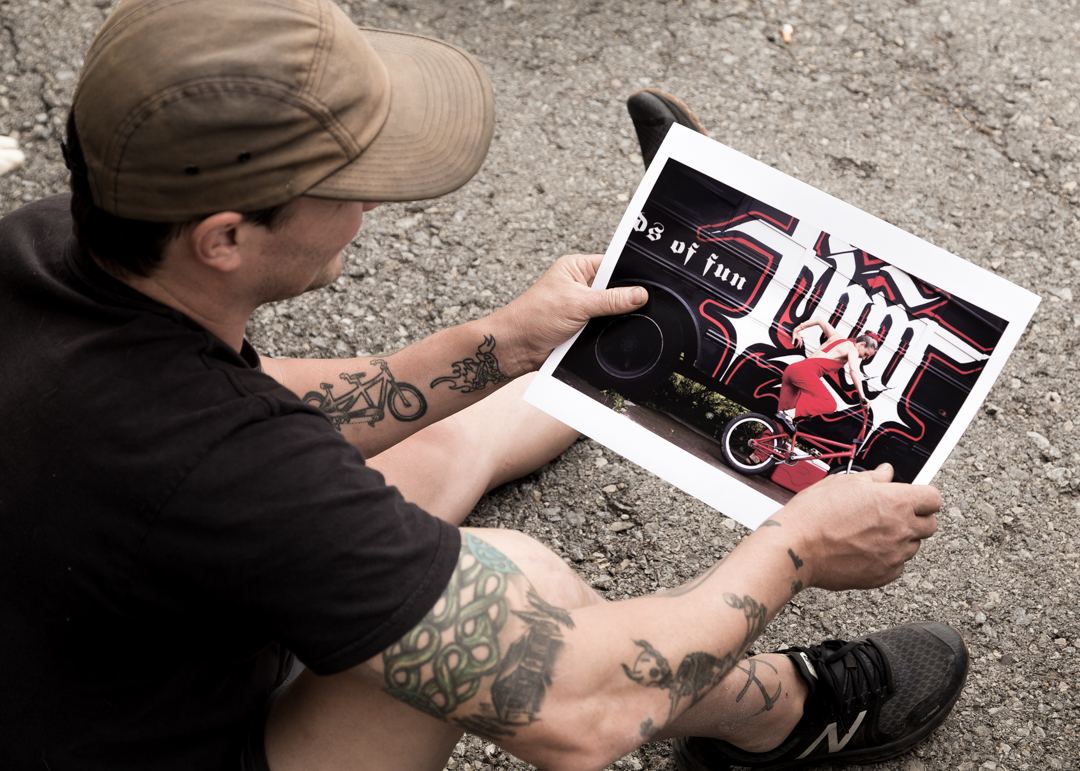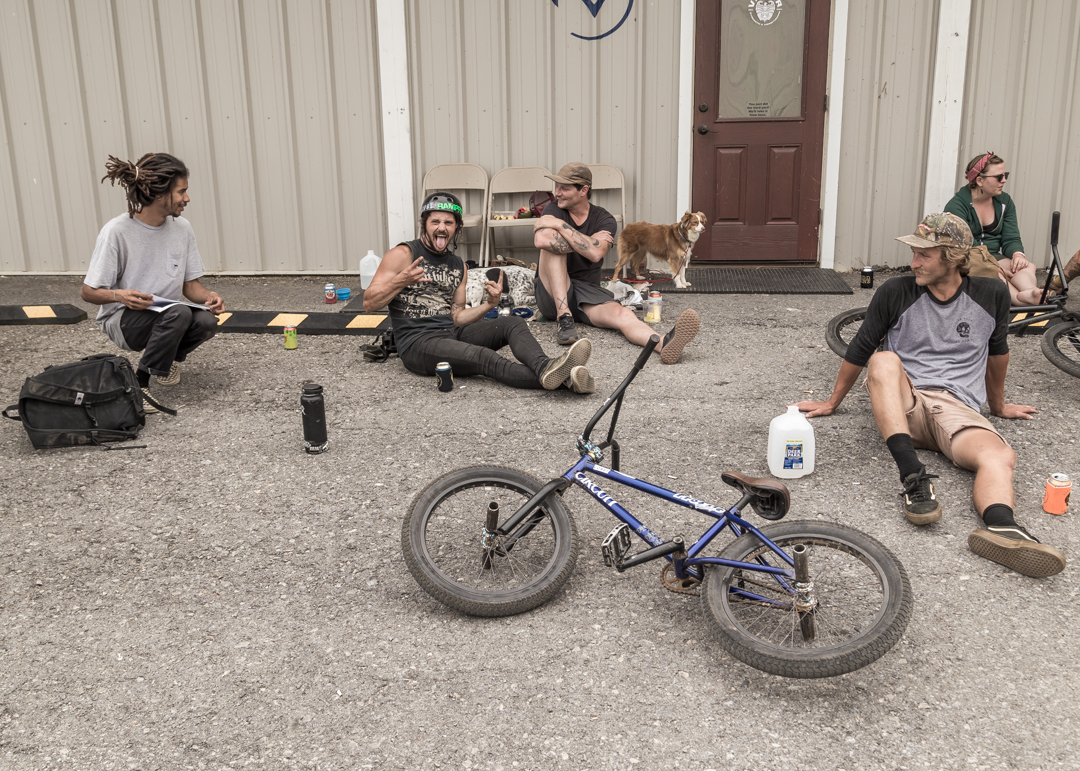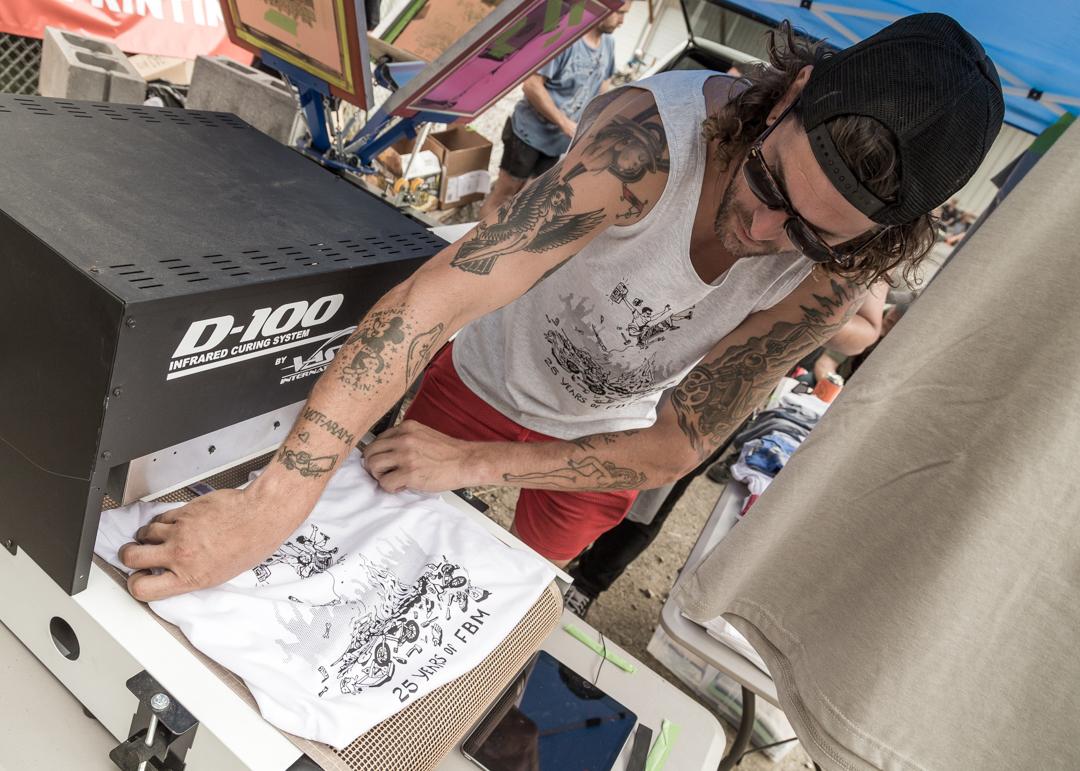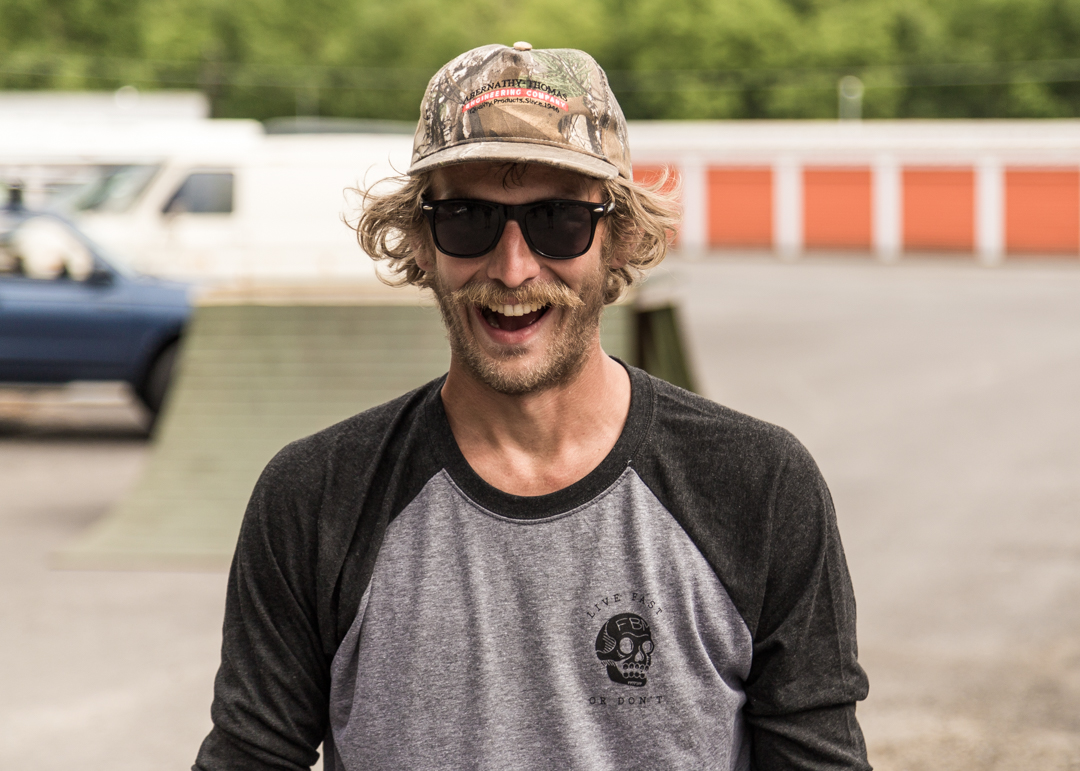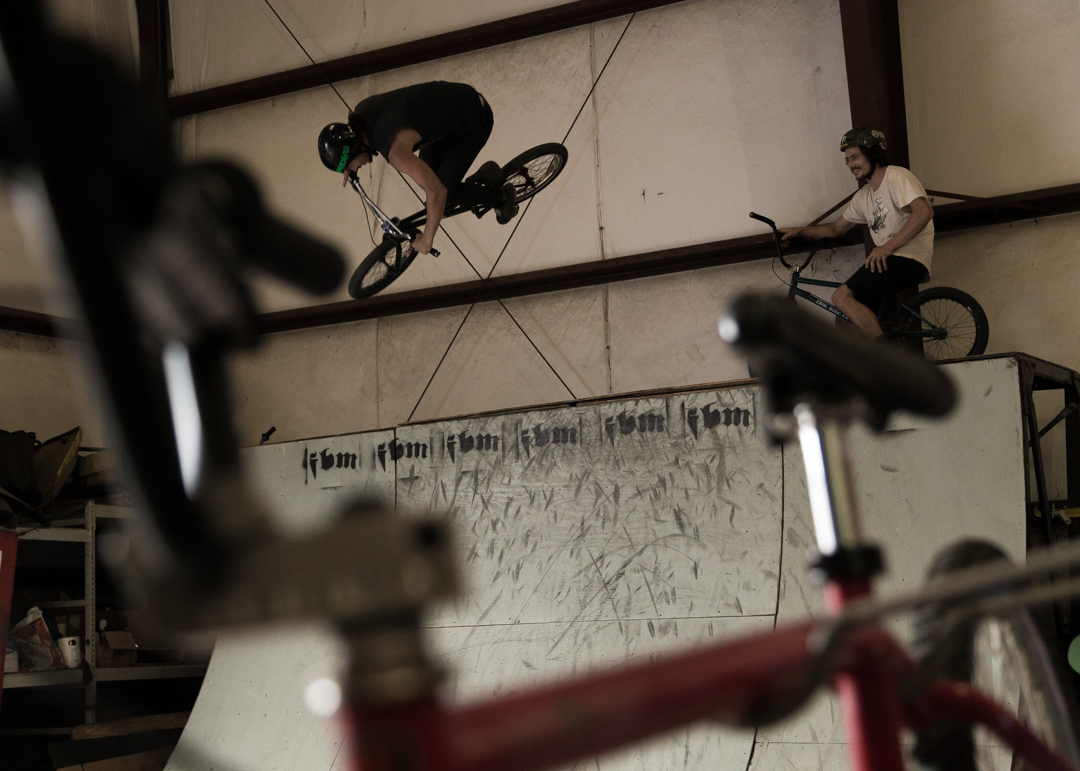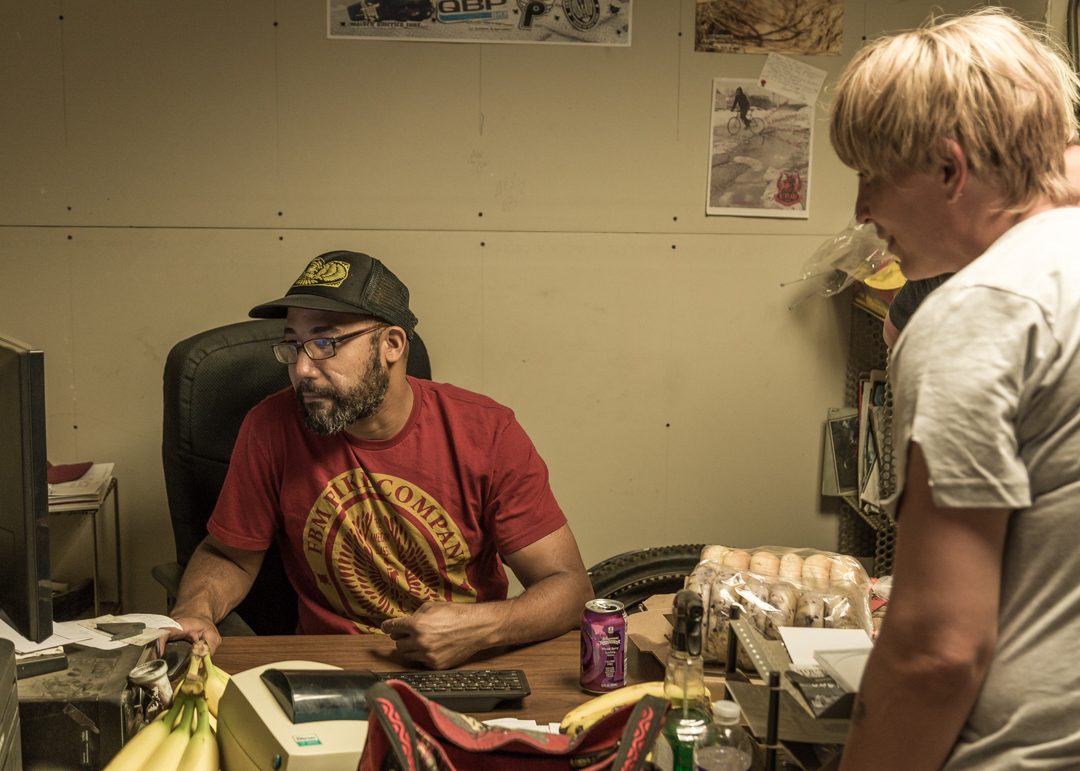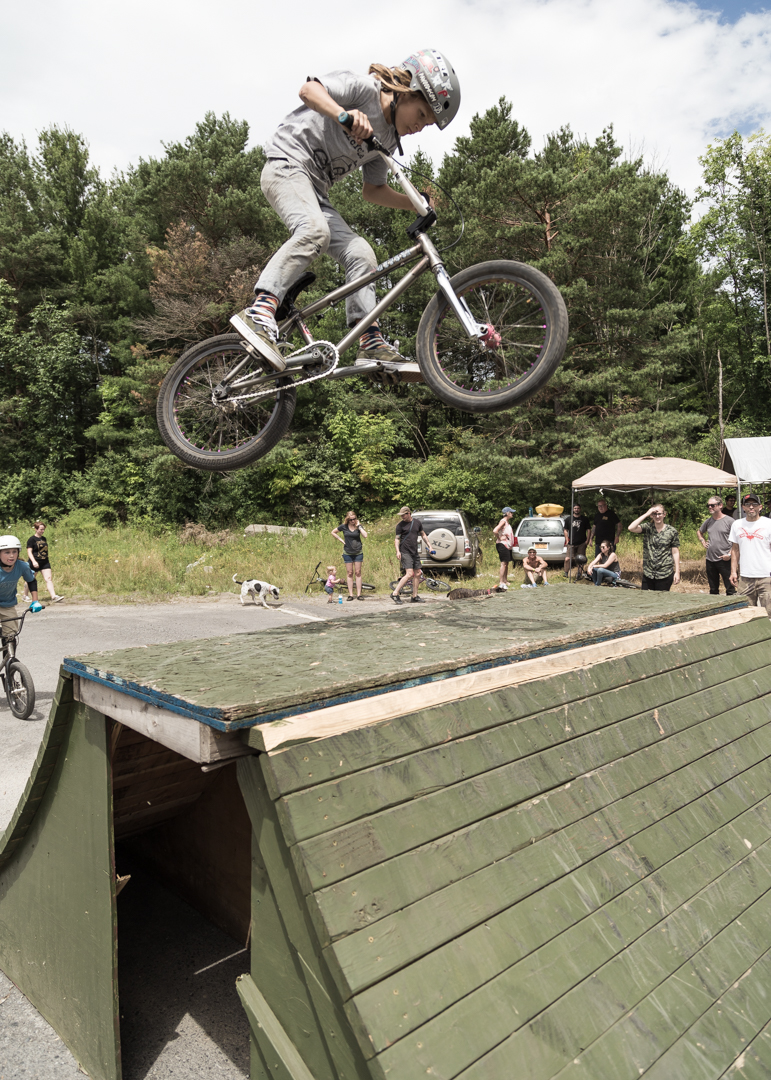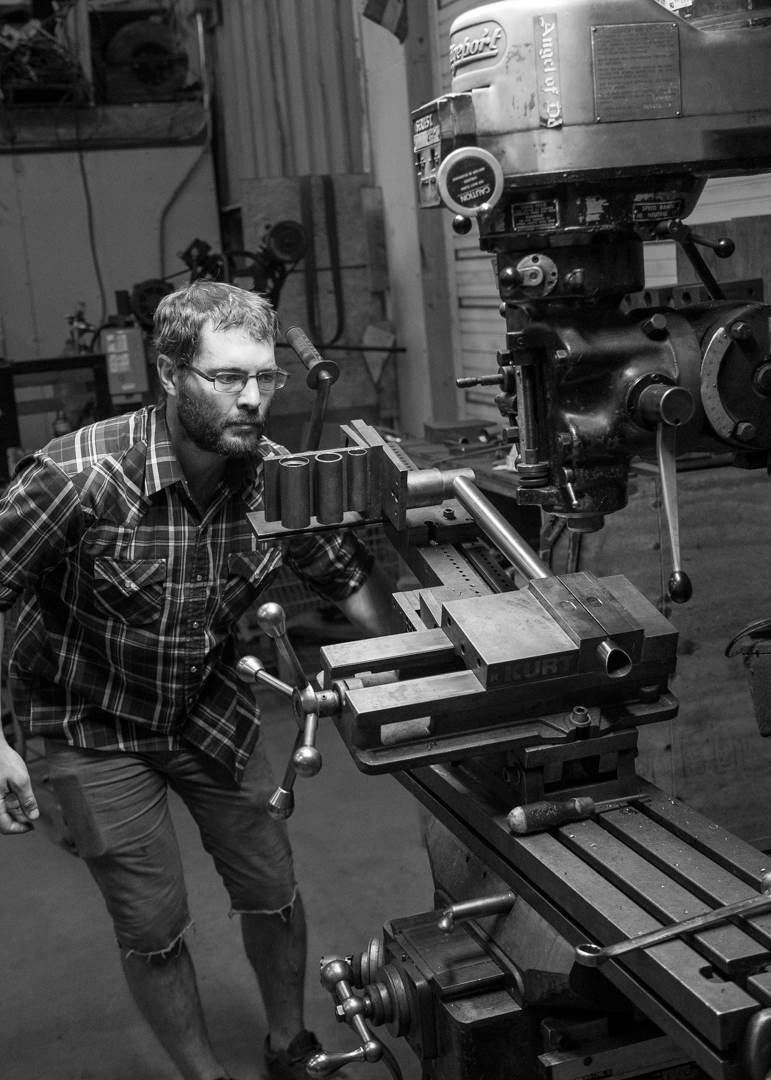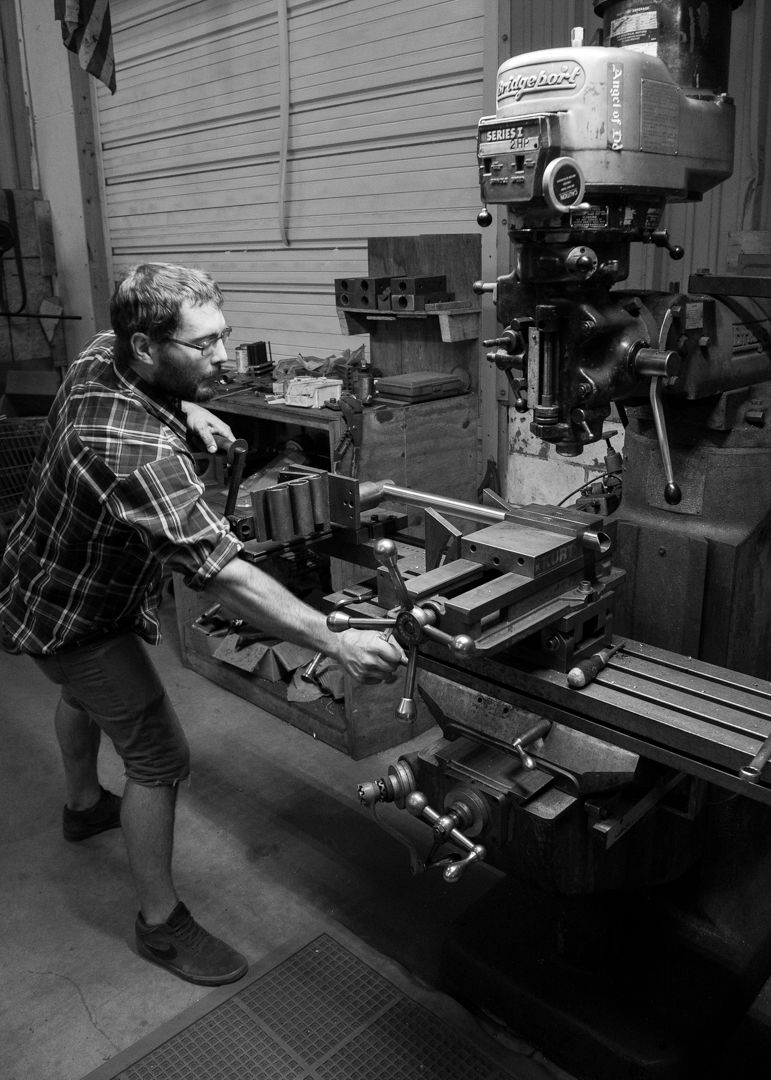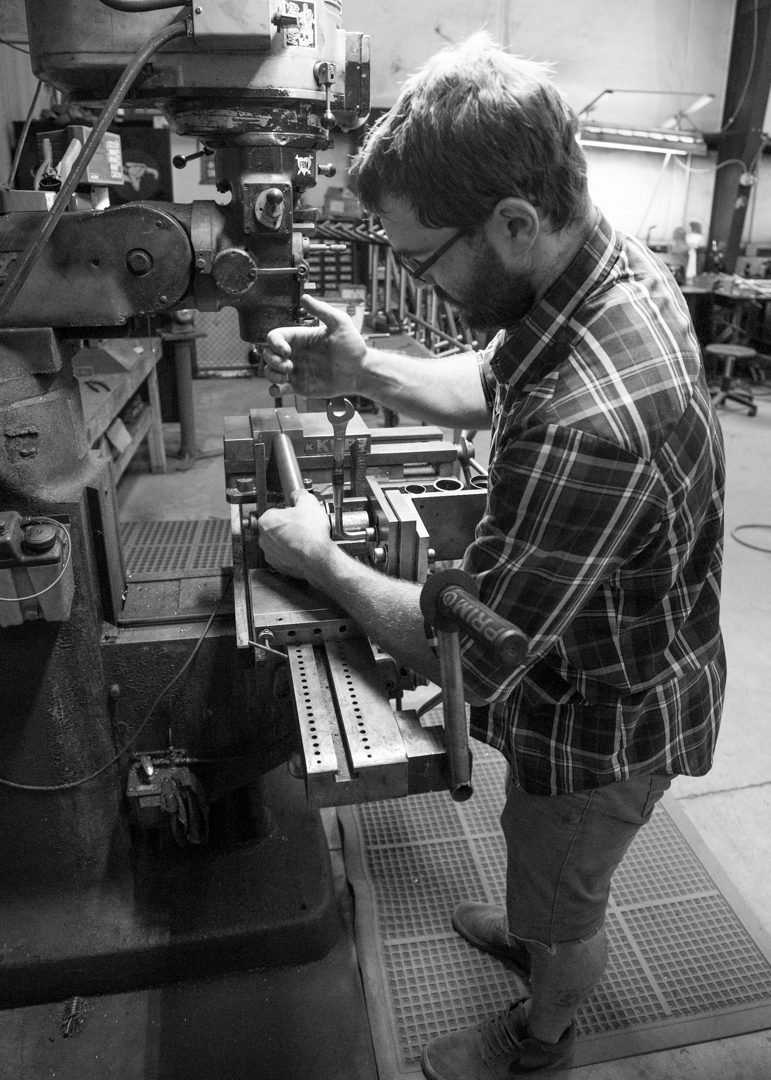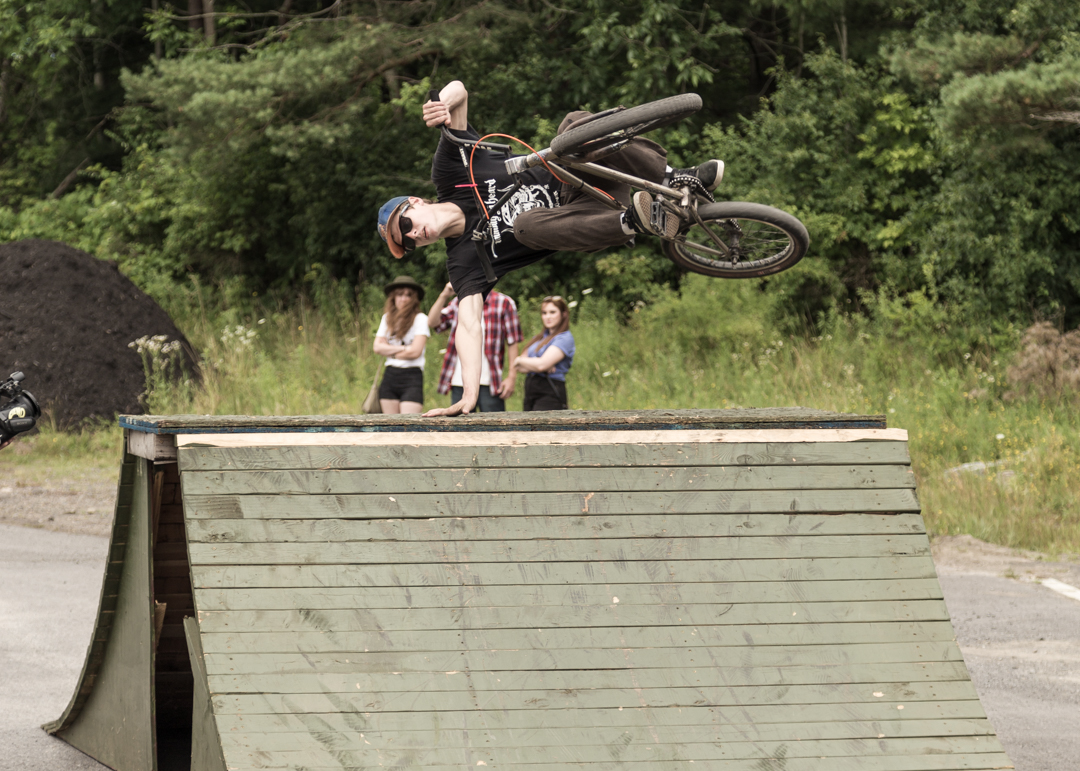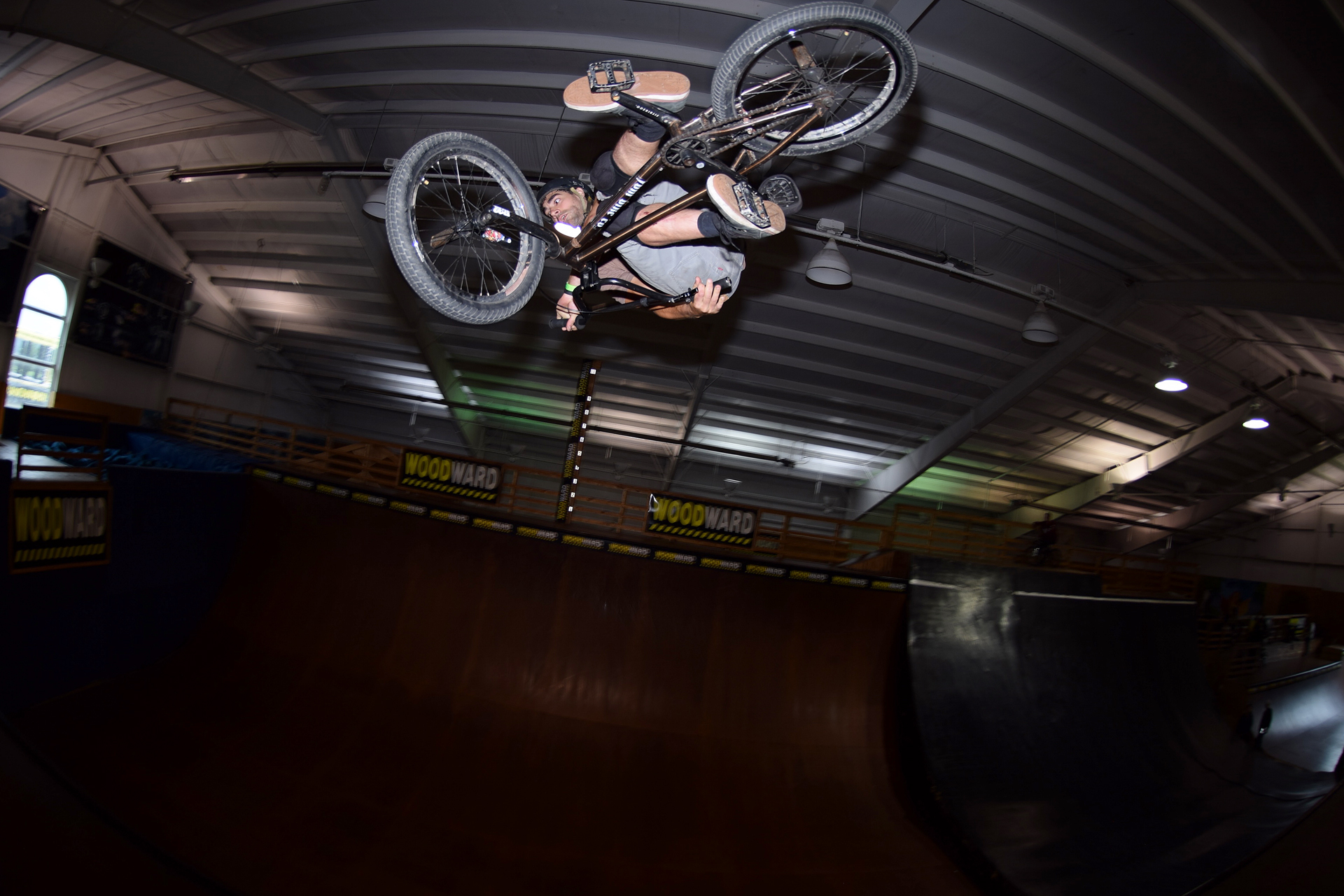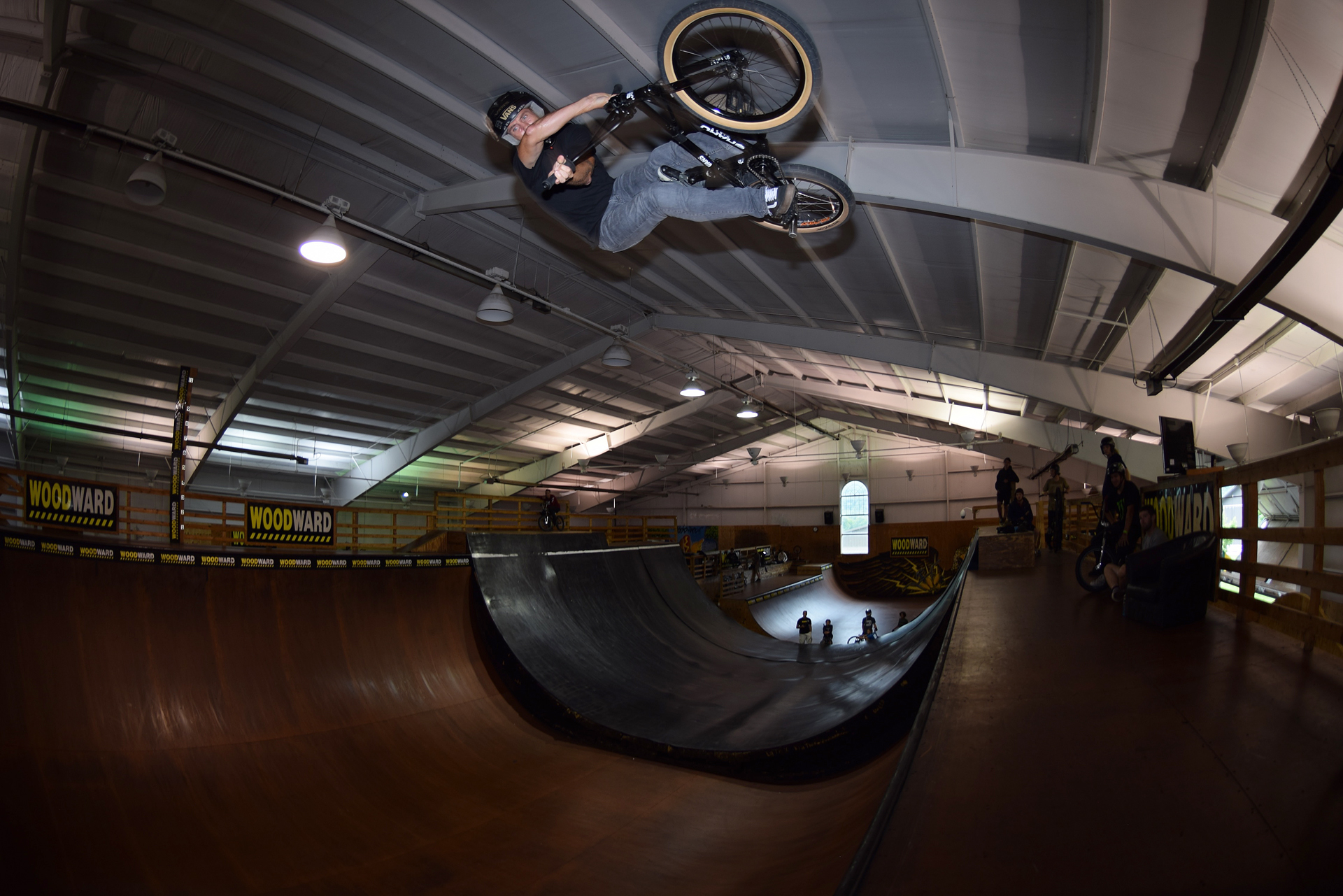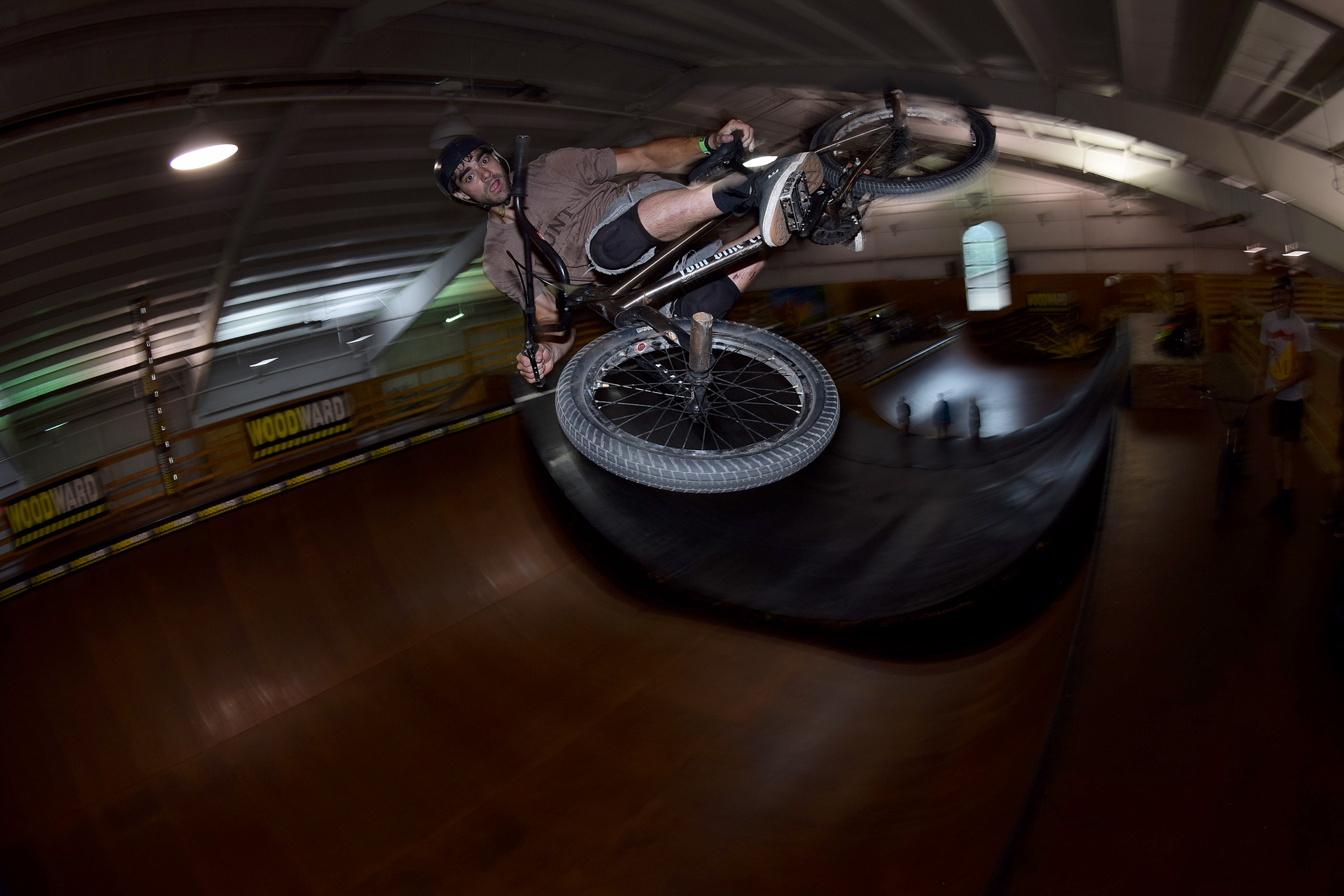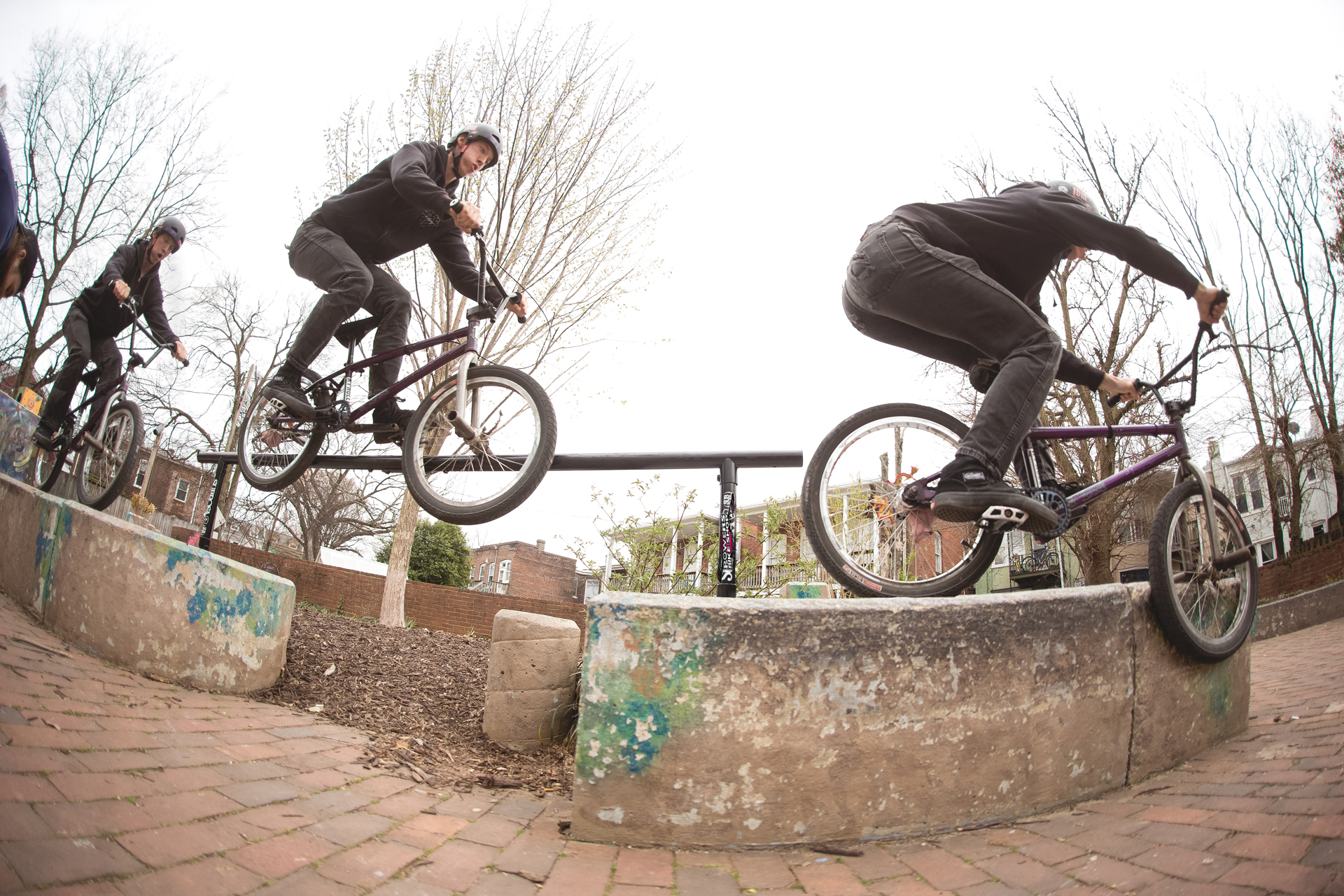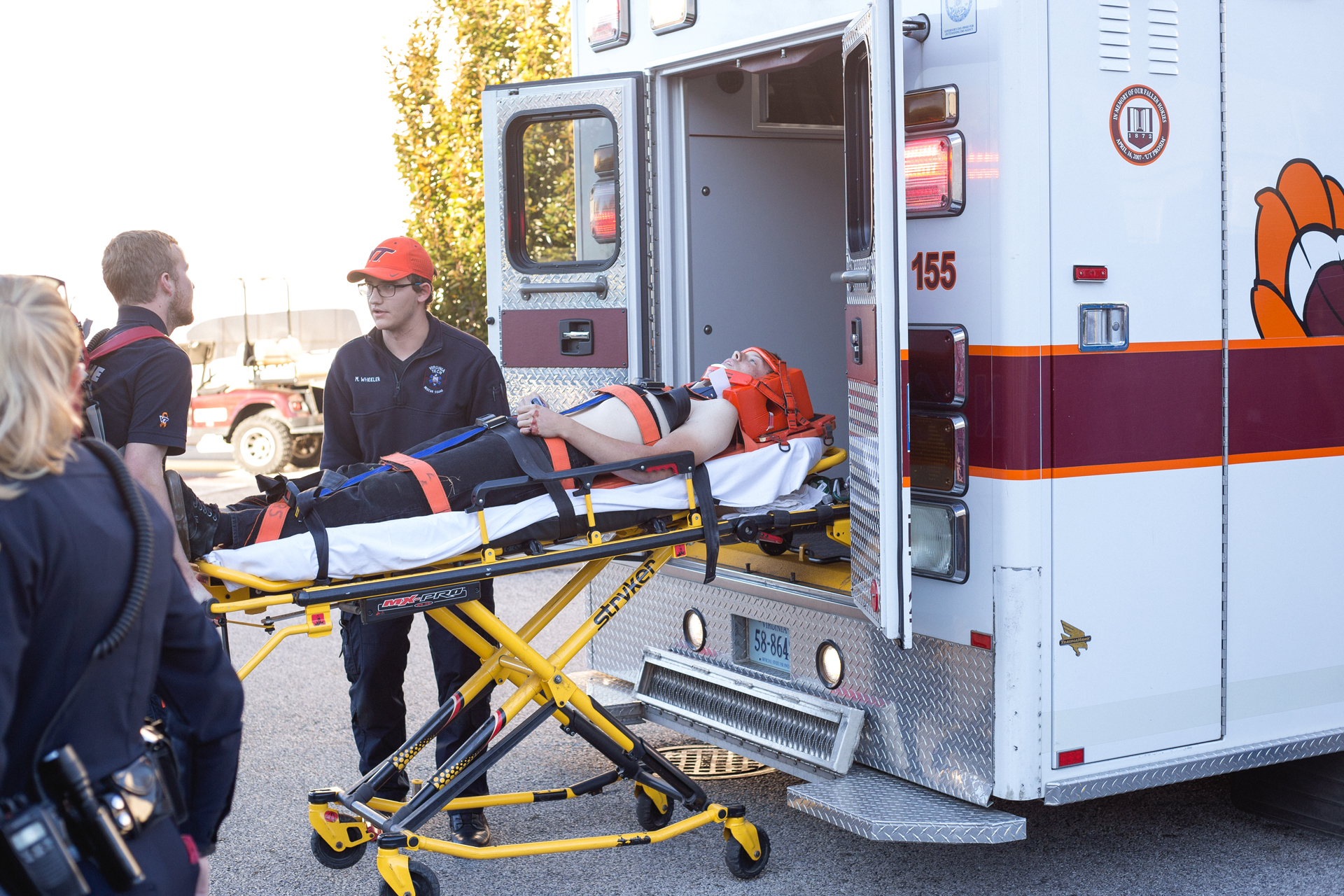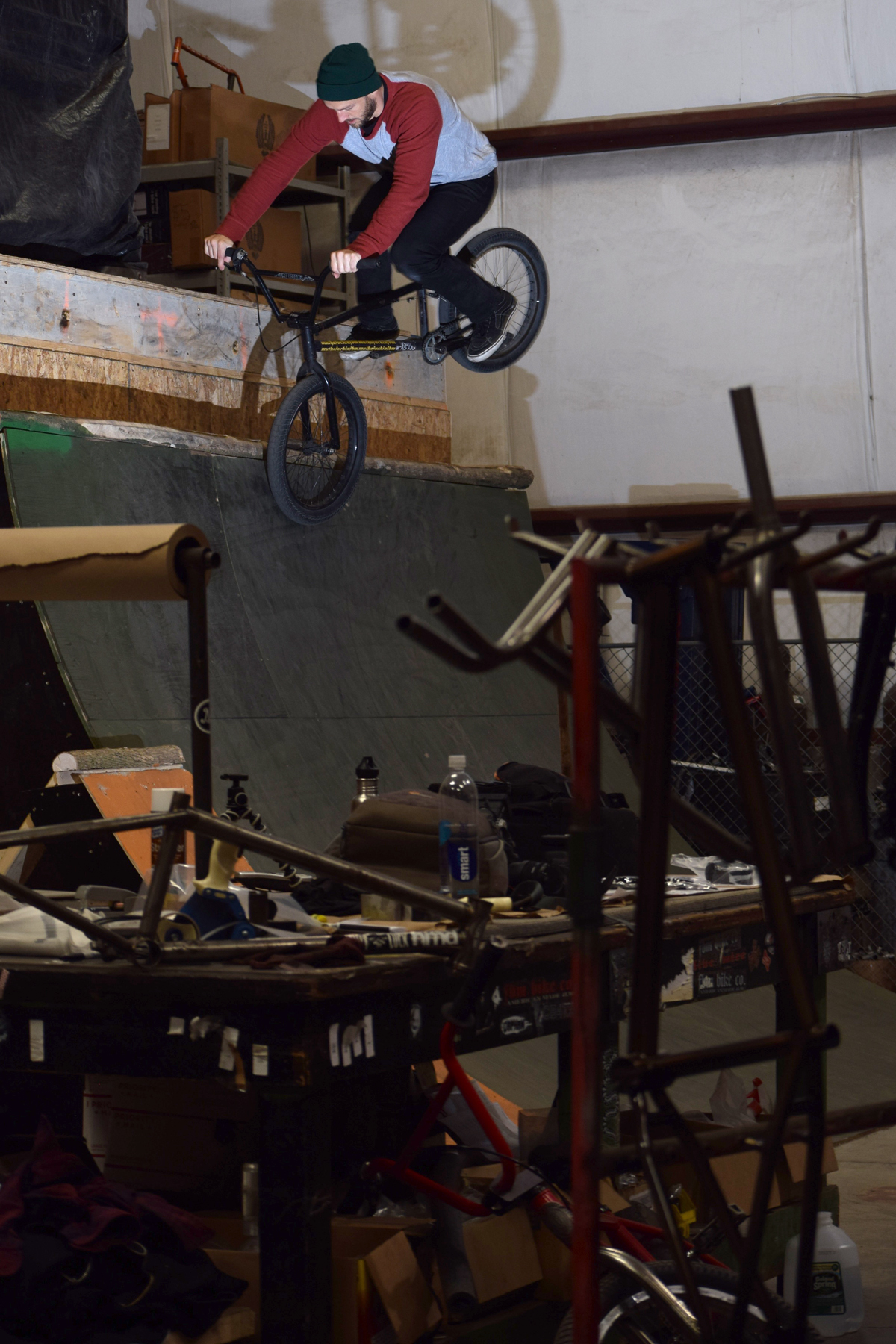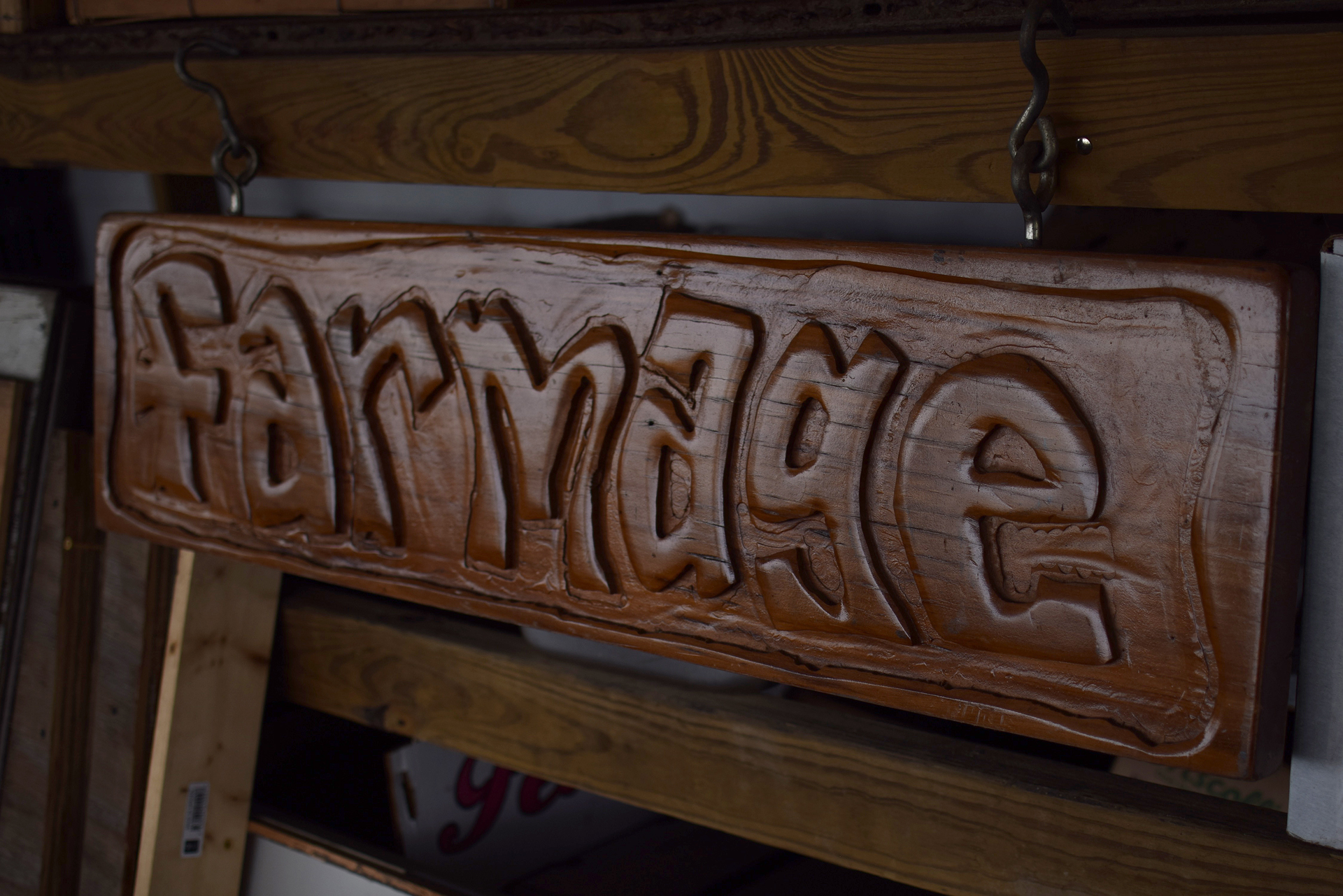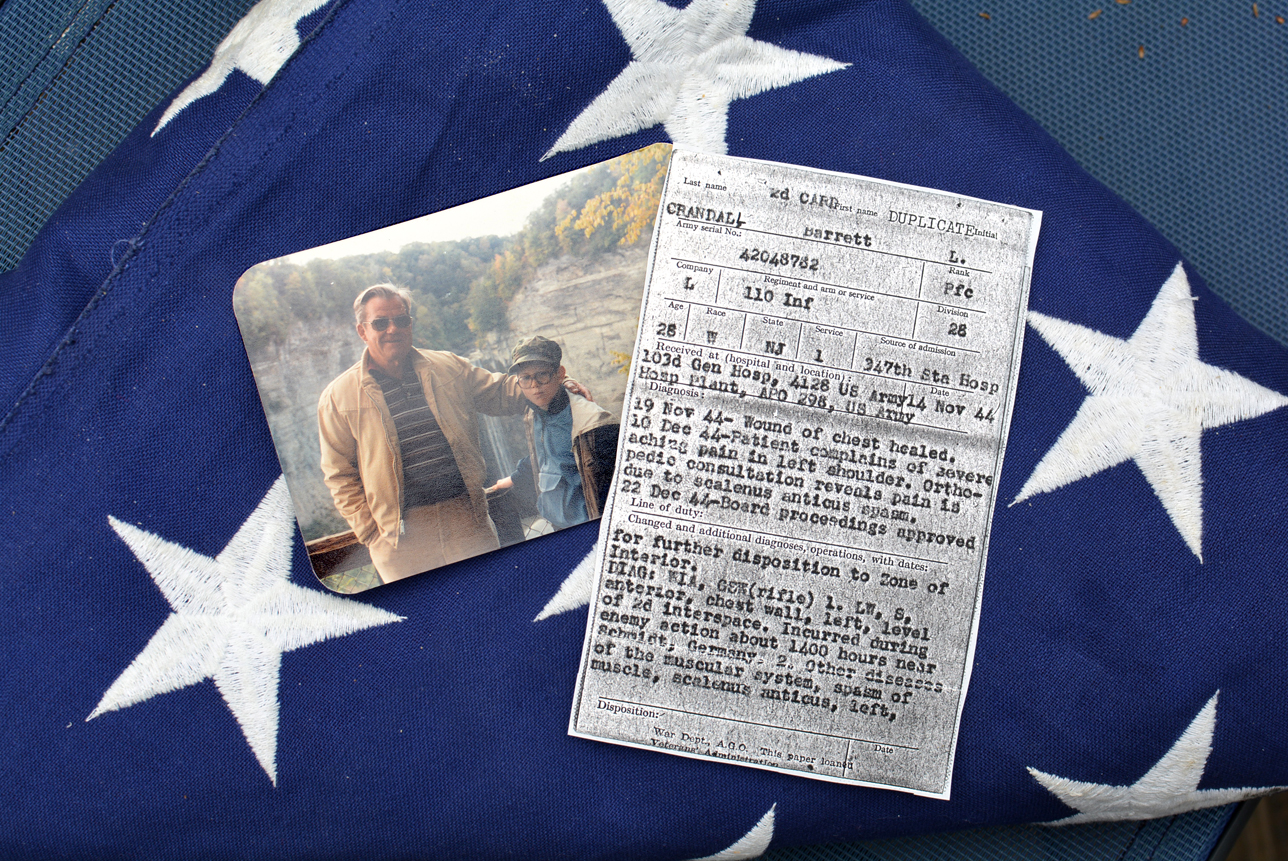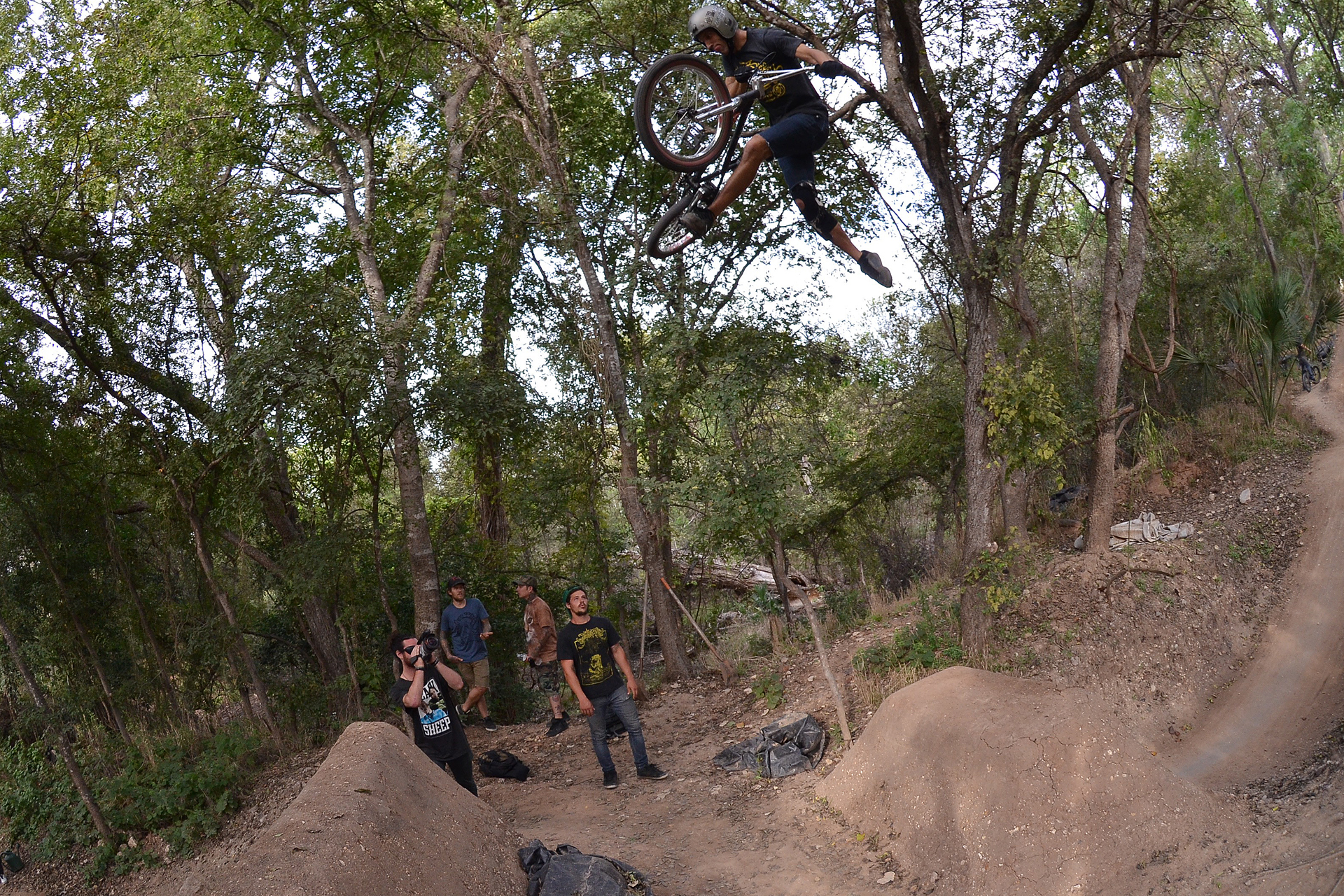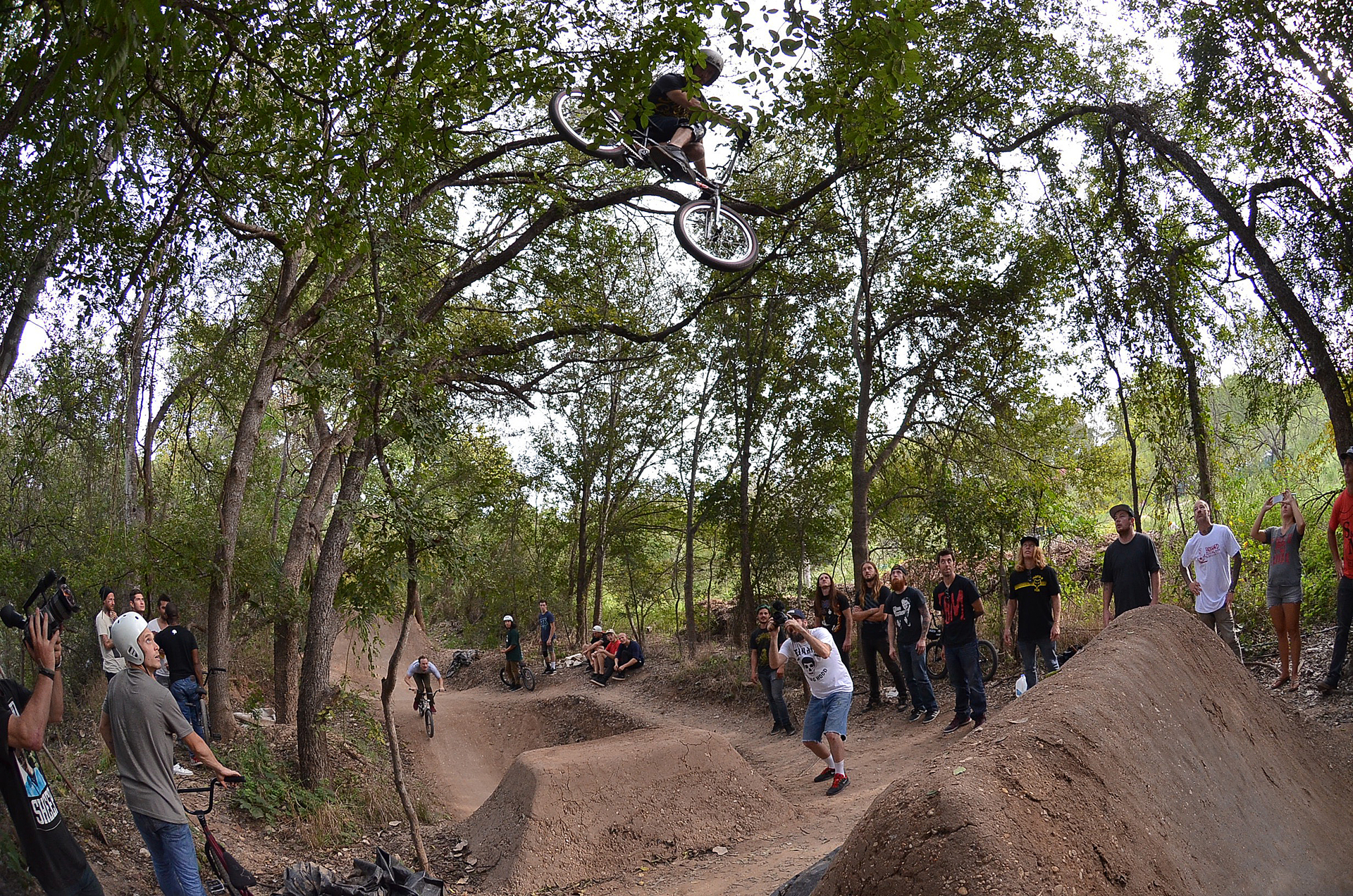Steve Crandall

Coffee sipping pilot of a red FBM frame and a Nikon camera.
Posts from Steve:
FBM Open House Photos!
25 years, one afternoon, a thousand words or more in Ithaca New York for a small celebration of the spirit of fun!
Photos of the FBM Open House- Shot By Matt Hovermale!
read moreVert Disqualifiers
The Zoo, DMC, Jamie Cooper Ellis and Clint Reynolds on the woodward Vert Ramp trying to qualify for X-Games Cafeteria food….
read moreKeep It Rollin…
Curtis Cantwell and the Keep It Rolling crew have been working hard on their big video project ‘440 Volts’. In conjunction with the video’s release, I sat down with Curtis to talk about his epic roof roll-in attempt to ambulance ride.
Was it a questionable judgement call? Of course. The difference is that you and I would have climbed down off of that roof. Curtis was dropping in. No matter what.
 What we can all take away from Curtis plowing himself into the ground that day is that sometimes, in BMX and in life,  you just have to fly your ‘Fuck It’ flag, let go of the brakes, and roll in.
Well, Curtis. What happened out there?
You want me to just explain the whole thing start to finish?
Yeah, let’s hear it.Â
I first noticed the arches on this building in June of 2016 when I was on the Virginia Tech campus riding one day. I kinda pointed it out as a joke like ‘How crazy would it be to ride down that?’ I took a couple pictures of it and left thinking maybe I would come back to it some day. I ended up looking at the pictures I took almost every day for a few months till I convinced myself I had to do it next time I was in the area.
Fast forward to the first weekend in November, I ended up riding in Roanoke with the Leeper bros, Kaleb Bolton, Taco, and Donnie Allen. We all made plans to ride the Va Tech campus on the last day of the trip. After obsessing about this spot for the past five months i just had to do it. I even bought a spool of rope the day before so i could tie it to my bike to pull it up the building.
After riding a few spots I convinced everyone to come over to the stadium and help me film this clip. They had all heard me talking about riding down this arch but I don’t think anyone really believed I was gonna do it till I pulled the camera out.
After we got all the cameras set up i realized I had forgot my rope in the van that we parked a couple miles away so Dillon and Donnie somehow were able to carry my bike up to me using each other for support climbing up the arch.
I remember sitting on top of this building and being too scared to move. By the time Donnie got up to me with my bike I was really freaking out. I kinda new I had made a mistake at this point but I was in too deep not to do it. Donnie was slowly sliding back down the arch and I yelled down to him to hurry up and get down to film. Thinking about it now I probably sounded like an asshole but I knew if I Â was up there too long I wouldn’t come down.
I was almost paralyzed with fear standing over my bike up there. I didn’t even want to ride down it at this point but I was too scared to climb back down. In my mind, my choices were either ride down, or sit up there and wait till someone could get me down on a ladder.
Once I saw Donnie had got down to his camera and everyone was ready, I looked around and saw a group of students had noticed me and were running across a field to come see what was happening. I didn’t want a big crowd watching me so I yelled down “this is it!” Put my feet on the pedals and took my finger off the brake lever.
I later found out everyone with me had expected me to ride down with my brakes and go as slow as possible, but that was never my plan. I knew I Â would go down fast but I didn’t have any idea how fast it would actually be. About halfway down I could see how fast the ground was getting closer and I got this horrible feeling. I don’t think I can accurately describe it, but I Â just knew that I was screwed. For that second riding down I 100% believed that I was about to die and I just regretted so much.
Then everything was dark. I opened my eyes and I was in a hospital bed in a neck brace with Donnie sitting beside me. I turned to him and said “I guess I didn’t land it huh?”. I forget exactly what Donnie said but then he handed me his phone and told me I had to call my mom. He said he hadn’t called her because he didn’t want her to hate him for letting me do something so dumb.
“I 100% believed that I was about to die and I just regretted so much.”
How did that phone call go? Was she pissed?
Uhh I don’t remember exactly. I do remember thinking she might freak out but she stayed pretty chill. I think she just wanted to make sure someone else drove me home hahaha . After I talked to my mom, a nurse came in and told us to leave. Kaleb took this photo in the hospital parking lot right before Dillon drove me home in my van.
I later found out that I had woken up multiple times before getting to the hospital and had been trying to get up and walk away while Dillon had been holding me still waiting for the ambulance. They told me that the police showed up and asked them what had happened and they said I flipped over in the parking lot from a pot hole or something, and as they were loading me into the ambulance I Â went “what!? I thought I rode down the building!? “I don’t remember any of that though.
What was the extent of your injuries?
I had a pretty serious concussion but overall I was super lucky especially considering my bars had smacked and broken the strap of my helmet during the fall so it fell off before my head ever hit the ground. I’m lucky my frame took all the damage from the fall. None of the welds fully broke but my downtube actually wrinkled and my frame pretty much bent in half. If all that energy had gone to my spine I would have been so screwed.
So I ended up getting the best case scenario for this going as bad as it did. Although I did end up getting a brain MRI almost a year after the accident and the doctor showed me spots on my brain where it had been bleeding and said there was still evidence of a major concussion in my past.
I think that’s pretty much it, sorry if that was way too much detail haha.
No way dude, that was amazing. So do you have to keep going to the brain doctor for follow ups?
No he said it was healed
I mix up first letters of words some still though
Everybody does that sometimes. It’s no dig beal.
Yeah I definitely had a hard time for a about a month afterwards forgetting names and stuff but that mostly got better.
Do you still have the frame?
Yeah, I still have the frame. It was only a couple weeks old so there are only a couple scratches on it and the paint still feels brand new. Such a shame it’s bent in half.
That’s a wall hanger for sure.
Another funny thing is they said it was gonna be a $12,000 hospital bill. But someone at the hospital filed it as a workplace injury so they wanted my employer to pay for it. I have no idea how that happened but we have never gotten the bill.
Are you going to get redemption on this thing or what? Does it count if you put a board at the bottom?
I thought about maybe trying it again for a while but i just don’t want to go through that again. I think it is possible if there is some transition built at the bottom. I don’t know if it’s possible to land it without extra transition because it is very steep at the bottom.
It’d be cool to land it, but i feel like the potential for a bad outcome is much higher than landing it.
I just remembered I saved this link. Someone caught me on their twitter (click Here!)…
  (Ed Note: The Tweet Link is worth pursuing for the comments alone)
The legit angles are going to be used in the new KIR dvd this spring
Imagine being like a normal college kid minding your own business, on your way to Starbucks, and seeing this lunatic ride off of the building.
So what’s up with the KIR dvd? You have a full part?
I have a six minute part. Hopefully people don’t get too bored of watching me fall for that long.
Somehow I doubt it.
Check out the premiere of ‘440 Volts’ at Powers Bike Shop on Saturday, June 16th at 6pm. Â
Interview By Kitt West photos by Kaleb Bolton!
read moreThe 90’s guide to traveling cheap…
A non comprehensive guide to getting by while on the road…
Times have changed so some of these innovations will be irrelevant, some of them are petty crimes, nonetheless the easiest way to get by, traveling with limited means is to fill your car with like minded wanderers so you can all split the cost of gas, food, and sometimes a seedy motel.
The first obvious thing to do to save money is buy food at a market rather than off of a value menu at a fast food joint, 4 dollars of potatoes, beans and tortillas can feed 4 people at about a dollar each, and you can spice it up with Taco Bell packets of hot sauce or BBQ flavor from Arby’s. Granted convenience and bad planning go hand and hand when you are young and in the wild so here are a few tips….
-The great soda machine heist was often a good resource for coins, high fructose corn syrup, and caffeine for teenage hoods on the go. By leaning the top of a soda machine towards you, careful not to lean too far and drop on yourself, letting it fall back, would typically yield 7 or 8 sodas, the entire front rack, one of each flavor. This worked best on older rectangle coke machines, and only once per fill up…
Another option, never quite consistent, was taking an empty 2 liter bottle, filling it with salt water, stabbing a hole in it’s cap, and using it to spray the conductive water into the dollar bill slot, while your buddy pushes all the buttons, if it worked, money and cans of soda would fall out, I can’t be sure the salt water worked or if it was just the blatant vandalism and dumb luck.
– the Groover, this was the slang term for a dollar bill, with clear packaging tape taped to the end of it, making a handle essentially, so you could insert it into a vending machine, and gently pull it back out after it gives you credit, while you keep the dollar bill. If you are in a hotel lobby, in one of the vending machine coves, with a pillow case you just stole, you could sometimes leave with 20 bucks worth of twix bars and cheese-its, while also getting the .45 cent change from the dollar bill registered by its tiny computer.
Times were so lean in the old days it was often a great internal debate to keep the groover for future raids or spend it.Often your last dollar.
– Gas and Go, this is flat out robbery. I never really felt good about stealing, but if 4 of you are milling about at a gas station getting Little Debbie snacks for a quarter, it wouldn’t be uncommon for someone to tell the driver, ‘Ya I paid the cashier…’ and then we would just drive away. The crime would only be uncovered later when the 12 bucks total ante’d up prior was reimbursed to each passenger.
– the Dialer, this was a semi obscure dialing mechanism that was sold at radio shack so you could check your home answering machine while on the go. Somewhere along the line, some nefarious genius discovered that by manipulating the device you could use it on payphone to make it think you are depositing quarters, making it so you could make long distance phone calls for free. This was crucial, as you might need to line up a place to sleep in Iowa, a spot to ride in Massachusetts or speak to your parents during holidays. Holding it up to the receiver pushing #9 would emit a digital code giving you access to free communication.
Another trick was calling a 1-800 number and getting the operator to hang up on you, wait a few seconds, and a dial tone would return to the line, and you could make calls on there dime…
– DriveThru hustles are key, even if you didn’t buy anything at Wendy’s or Rally’s you could grab a receipt out of the trash, boldly wait in line like you are totally fed up with the terrible customer service, and tell the kid at the counter that your drive through order was wrong… Simple, effective fast food larceny, it would be a victimless crime, but really that food could kill you.
– Campsite boogie, this one is a little bit of a bummer, because hustling the parks system sucks, but so does being broke and having no place to stay. In these scenarios, if you show up to state park campsite, after the ranger or attendant is off duty, at the pay station/check in, they typically have envelopes, where on the honor system, you leave the 18 or 26 bucks, write down your site number and leave it in a drop box. If you are clever, and have a spare 20 dollar bill, you keep that in the envelope on your dash, with no intention of paying, but if a ranger shows up, you can simply tell them you need change and hand them the paperwork. 99 times out of 100 you can just drive out unnoticed in the morning…. Although pulling a fast one, we always made sure to never leave a mess or litter.
– the Big Gulp shopping spree, this little known trick can be useful, if you take a large big gulp, walk around a 7-11 or whatever gas station convenience store, you can fill the cup with random road trip survival necessities, the easy method is getting a king size snickers, tossing it in the cup, before you fill it with soda and ice, and bingo, a two for 1 bargain, the cashier rarely suspects as you pony up the .99 cents for a cold soda. Other options include dropping a pint of Ben and Jerry’s ice cream into the bottom before filling up (It actually fits), or dropping batteries, film, small canned food items, anything packaged as to not get destroyed by the carbonated camouflage. Not sure if this is a shopping spree or a petty crime spree, but it’s almost justifiable if you are actually buying the drink.
Trying to cut down the cost of travel and stretch your last dollar always seemed pretty innocent 25 years ago, so a little road trip ingenuity often kept it moving for us…
read moreFoundation Building Materials
American dreaming… Ithaca New York.
This was all shot during a quick late winter session at the FBM Warehouse, which also houses the FBM Machine Shop! (more…)
read more1000 WORDS
BEHIND THE SHUTTER WITH MEL STOUTSENBERGER
The basis of this interview is purely selfish. As a child of 70’s BMX, I’ve been infatuated with the photos of Mel Stoutsenberger since I first laid eyes on them. His ability to capture not only action, but the atmosphere and electricity of the moment is uncanny. Background details, the weather, the motion, the attitude–it’s all there, in that sliver of time. I had to know more about the ‘how’ and ‘why’ of these photographs. I’ve met Mel, and in person, he’s a soft-spoken, kind individual, despite his towering height. Acting under the pseudonym ‘Rappensuncle’ created some identity-confusion, as the ‘screen name vs. Real name’ paradox blurs reality, but the real Mel is the real deal. Mel was there at the very beginning of Bicycle Motocross. He was a participant and observer, but more importantly, in a historical, soulful sense, he was able to capture the magic of the era with his photography. The following interview came graciously and openly. Mel’s contributions to ‘our world’ can never be done justice in words, they must be viewed, studied and digested. Fortunately, Mel has done an incredible job of archiving his work.
Please take a look at more of his work via Instagram @rappensuncle and consider buying a print of at Rappensuncle-Smugmug
-Thank you and much respect to Mel for his time and candidness.
State your name and where you are from?
My name is Mel Stoutsenberger and I am from San Gabriel, California. Hometown; Canoga Park, California.
When and how did you discover BMX?
My Dad bought me my Stingray for my 9th birthday in 1965. BMX wasn’t a thing yet. What I discovered was Motocross. I was a 12 year old boomer and I went to Columbus Junior high and my friends and I rode our Stingrays to school every day. We learned how to do short wheel stands, do jumps off curbs and stop fast by skidding – simple stuff like that. So we’re all hanging out down the street on our bikes after school and this dude comes rolling up the street and he’s doing a long-ass wheelie but he’s doing it with no hands! We were freaking! Then he starts spinning his bars around and around as he goes by! I knew the guy – older brother of one of my friends from church – so I jump on my bike and start following him. He notices me chasing him and immediately kicks it into high gear. I catch up to him so he hooks-it over to the curb and bunny-hops up it! “Later!”, he tells me. I’m thinking, what the hell did I just see?! I started practicing and learning all I could about motocross from that day forward.
So, you were a rider/racer in the very earliest days, long before BMX was a ‘thing’. How was it that you began taking photographs?
I started taking pictures at a young age. My parents both had cameras so I would ask them if I could take pictures for them at family events and vacations. I liked what I saw when the pictures were printed so I started asking to use their cameras more and more. My parents saw my growing interest in photography so they bought me a Kodak 126 Instamatic for Christmas when I was 12. I started shooting more and taking my camera with me all the time, but it didn’t work well for shooting fast moving objects. I started reading books about photography. The Time Life series was my go to back then. I learned how simple it was to develop black and white film, but the 126 film I was using came in cassette form. My Mom and Dad had 35mm cameras but my Dad lost his and my Mom’s Zeiss jammed-up. I had to get my hands on camera that shot 35mm film, so I saved my money and bought a Japan-made Sears 35mm SLR with a 55mm f/2.8 lens from a guy in school for 50 bucks. I was officially hooked! I took photography class as an elective my first year of high school so I could use their darkroom equipment. I was working it big time! I thought I had this shit down until I met Russ Okawa.
The familial influence and studying explains the basics of your photography, but the vision, composition and most of all, timing, is uncanny. There were so few existing examples of how this kind of action should be timed and framed back then. Keeping the terrain in the shot, the subject higher in the frame, the apex of the jump–these are things that are taken for granted now, but how were you able to pinpoint it all and capture it? Was it conscious, or do you just have the supertouch?
Good question! It was definitely a conscious visual perception and something I strive to do in every shot I take. The fact that I knew most of the guys riding and racing back then made it a lot easier for me to get the shot I wanted. I knew that certain riders were going to fly farther, go a lot faster, and take a certain line through a sweeper better than other riders. That helped me compose my frame and get the timing and focus dead-nuts before a race even started. I knew the tracks because I was racing on them, that way I knew the line variations and tricky sections to shoot when I’d circle-back with my camera. Composition trumps quality in the photographic world. I didn’t go to a school of design or work for one of the masters, so I did the next best thing; I studied the works of the masters. BMX was a new sport and there wasn’t swarms of photographers out there grabbing a piece of the action. There wasn’t much to look at as far as examples, but there was the sport of motocross and it was being well documented. I bought a subscription to Motocross Action Magazine and studied the masters of motography – the angles used, lens selection, what type of film and camera settings. Everybody knows what they like, but the real trick to a well composed image is the ability to guide the viewer in and tell a story. That’s what good composition is all about and what I try to achieve in my work.
What was your involvement with BMX racing? Where and when was the first organized race you attended?
The first time I ever raced at an organized bicycle motocross event was in the summer of ’72 at Indian Dunes Motocross Park in Valencia. The organizer was Ernie Alexander and this was the first sanctioned racing event of it’s kind that I know of. It was on a Friday night and the track was laid out on the inside of the site’s minibike track, so it had bright overhead lighting and plenty of parking for the 60 or so riders that came out that night. I was working part time at Canoga Cycle Center and my boss was Russ Okawa. The shop already had a large following of guys who were riding motocross on their bikes, so when Russ heard about the Dunes race he put a team together and took us all in his Dad’s station wagon. I still have the team roster that Russ typed to give to our parents so they had all of our contact info. We raced every Friday night that summer and brought home lots of trophies. Each Friday night the competition grew and so did our abilities. New parts were custom made for strength, we tried all kinds of knobby tires and gearing was changed to suit the different track layouts. Russ developed a two-speed clutch set-up out of a Sturmey Archer 3 speed coaster brake hub but it was protested and banned soon after. We also laced up a special fixed gear for John George – but that’s another story.
Regarding Russ Okawa, I feel like I’ve seen more of his photos in the past year than the previous 40. I know he was very involved in many facets of early BMX, but he was clearly understated as a photographer. What was his influence on you?Â
Yeah, I think that’s my fault. I have copies of Russ’s archives and I kind of shared them with some people. Russ was an amazing person and my best friend for years. When I met Russ, he was attending USC’s School of Cinematic Arts, studying to be director of photography. It was his dream to operate large format cine camera systems to produce major films and commercials. He was good at it, and his photography reflected his abilities to see well and get the shot. He taught me more about still photography in a month than I ever learned from years of reading books. I would go with him on assignment shoots and student film projects and I would work as a grip for the crews. I became part of the team and I was learning how to use all kinds of equipment and how to set-up shoots – it was insane! I had just turned 15 and about to start high school when I met him. I came into the bike shop to find out how to fix a flat on the back wheel of my Schwinn Continental, and we started talking. He let me build some stuff and then asked me if I would be interested in working part time. Hell yes! I showed Russ my Stingray that I set-up for moto and he asked me to show him what it was all about. He became very interested in the scene and started coming to the tracks and jumps that we had built around the area. He knew right away that we needed better equipment. One of my friends, Alan Johnson, asked me if it was possible to lace a ten-speed front hub to a 20″ Schwinn rear rim so I took his request to Russ. Sure enough, Russ found a 20″ x 36 hole Schwinn rim and calculated the spoke size and lace pattern. We took Alan’s hub and laced it to the new rim and the AJ Wheel was born! Once Alan hit the streets with that wheel everyone wanted one and the orders poured in at the shop. I was lacing and truing wheels for days and I still couldn’t keep up with the orders! Russ enlisted some of my friends to help and we started an assembly line. Russ also brought a guy in that he knew from his church to help, that’s when I met John George. These were all the guys that became part of Russ’ first racing team.This was just the beginning.Â
The bicycle motocross phenomenon exploded on this little bike shop in mega proportions. The owner, Burt Straub, bought a piece of land on busy Topanga Canyon Blvd. and had a full-blown Schwinn franchised concept shop built that we all helped him move-in to and set-up, complete with a motocross bike section with our race photos and trophies. I got my own service bench, tool kit and a nice raise! Russ graduated form USC and concentrated on the shop operations and managing the racing team. Team T-shirts were provided and Russ was writing checks at the races to cover entry fees. We were sponsored by Canoga Cycle Center, but everyone knew us as “The Schwinn Team” and we dominated where ever we raced.
Your early photos are littered with the “who’s who?” of early BMX:  Thom Lund, Rick Twomey, John George, John Palfreyman, as well as many lesser known (outside of SoCal) riders. Were these guys your subjects more from geographical location or did you seek these guys out?
Geographical for sure. I was on the Canoga Cycle Center team with John George, most of the other riders were from my neighborhood, so naturally they became my subjects. I’d shoot them when we would go to the races and if we heard about a killer new launcher or downhill we would meet there after work to join in on the fun. I met a lot of people that way and they would share their hot spots with us. I met a lot of really fast guys racing the NBA tracks; Dave Clinton, Marvin Church and Thom Lund (just to name a few) were always at weekend races. The out of town guys came to SoCal to race in the national events, so I would shoot them but I didn’t really know who they were until later. Â
What is “Rappensuncle”(Mel’s screen name and long time alias)?
‘Rappensuncle Thorch’ was my pseudonym for any BMX related images published back then. I remember thinking that I wanted to keep my work shot at motocross events separate from the bicycle races. I ran that thought by Mark Kiel one day and he answered with a quick thumbs-up. Typical me, I got stuck on the name, so Mark throws out the first thing that pops into his head. We laughed so hard that it stuck. To this day he still doesn’t have an explanation as to where that name came from and why.
Were you able to maintain a living wage shooting BMX and MX?
Never. I’ve never made a living wage at anything related to photography. I worked for a little while in a darkroom printing other people’s negs but that got old really quick and didn’t pay well. I don’t know, I could have applied myself more back then to sell my work, but I didn’t. But I never stopped shooting.Â
How do you have all of these photos cataloged? Are your archives comprised of prints, proof-sheets or what?Â
My negs and slides are in Print File archive preservers and those are in categorized three-ring binders. The binders are tucked away in a cabinet so light doesn’t get to them. All of the master scans are stored on external hard drives. Edited masters that I want to keep get backed-up with the masters and also to a cloud storage service – I use Flickr.com. All of my BMX stuff is in a file named “BMX”. I lost some of my negs along the way and unfortunately, some of them were my early BMX shots. I did have some prints of those shots but only a small handful compared to what I originally recorded. Shit happens.Â
At what point and why did you fade away from BMX? Where did you go?
There were a few reasons; I was way too tall to be riding a bike that size. Not that it was ‘A kid’s bike/I’m an adult with a driver’s license/what the hell am I doing?’ kind of thing. I never felt like I didn’t belong in BMX. I was just too damn tall! Then there was the Yamaha Gold Cup Series slap-down. What a bunch of crap! I couldn’t sign-up because I was going to turn 18 during the series! Myself and Ronnie Haase couldn’t race with the rest of the team and Russ couldn’t do anything about it. Bill Ford could have raced but he was so pissed-off about the whole thing that he quit the team. Butch was about to do the same, but we talked him out of it. The writing was on the wall; they didn’t want adults racing BMX. Ronnie was racing motocross anyway, so he left and didn’t think much about it, but we still rode together all the time. I left the team and raced now and then at the NBA tracks for Kiel’s Cycle Parts and then hooked-up with Rick Twomey and started riding with his team. Riding for Rick and Patti was the best! We traveled to NorCal, Las Vegas and Arizona, and Rick got me a job working for BMX Products during the beginning stages of the Mongoose production bike. We did most of the testing. Then the final slap in the face: Long story short; an opportunity to become an editor for a brand new BMX magazine was given to Rick and I felt betrayal. I was done that day – walked away from racing and never looked back. I started racing dirt bikes for the Kiel’s and shooting motocross events like there was no tomorrow. I customized another Schwinn Varsity so I could ride it like a BMX bike. Â
Photo attached…Check the custom forks – Thanks Ronnie!
You touched on something important. You said you “knew the tracks because you were racing on them”, which obviously gave you a perspective that a non-participant wouldn’t be able to simulate. Your ability to capture the entire scene, with secondary subjects in the background, is uncanny. You truly are a visual story-teller. In a shot of John Palfreyman you posted on Instagram recently, there is a ghostly image in the far distance of a rider pushing their bike up hill. Maybe this one instance was luck, but your photos are filled with such incredible background detail. How?Â
Yeah, some of that background stuff is just pure luck, plain and simple. I was concentrating on Johnny’s moves in that particular shot and he was moving fast so there was no time to check what was going on in the background. Back in those days, I didn’t have an auto-winder on my camera, so I only had one chance to get the shot. The only challenge at the races was finding the right place to stand for the best light and show as much of the terrain as possible. The rest kind of just fell into place. It’s much easier to tell the whole BMX racing story at the tracks because the background is filled with spectators and their gear. The best time to shoot a big racing event was at early practice when the guys were warming up and learning their lines. Plus, when the cameras came out, so did the radness.  Â
The way you explain it now, in a “professor-to-student” like manner, all makes sense, but I don’t understand how you had such a clear vision at a young age? You have a remarkable gift–reminiscent of early Glen E. Friedman shots (although yours are earlier). Who are some of the masters of “motography” you speak of?  And photographic influences (besides Russ Okawa)?
I think I was just in the right place at the right time. I was part of something in it’s beginning stage and I recorded it. Friedman’s images are remarkably raw and clearly capture the energy of the skater-punk scene. In the early 70’s there was this shooter named Craig Stecyk who got a lot of his black and white photos published in Surfer magazine. His images portrayed a small group of adolescent skaters from Venice and Santa Monica shredding storm channels and pools. His print work was sharp and gritty like the scenes he captured and his stories were killer. I wanted that same feel and energy in my shots. It’s from the street and it’s spontaneous and real. The motocross photographer I remember the best was Jim Gianatsis. Jim seemed to be at every race and was published more than any other shooter back then. My friends Mark Kiel and Scott Heidbrink, although just starting to know their way around a camera, were consistently turning-out amazing images portraying the motocross scene in southern California. I know that there was a lot more feeding my need to learn back then but I just can’t remember. If I could flip through an old Motocross Action Magazine it would come back to me.
I think it’s great that you’ve shared some of Russ’ photos. It’s a great way to honor him and his work. His influence as a an early innovator of equipment, teams and the core of BMX in general are huge, but his photography has gone unappreciated until recently. Thanks for enlightening us with the photos and now, this insight. Did you work with him in any other capacity after Canoga Cycle Center?
Thank you. Russ was a great photographer and cinematographer and a lot of people have never seen any of his work. It needed to be seen. I did work with him in one other capacity other than bike repair and BMX. When he was a film student at USC I would go with him to location shoots in various parts of LA. The film students worked in groups and they all had assigned tasks just like a regular production company shoots. Russ was always the DP so he would be on shoots for mass hours setting up camera angles and lighting. I was his helper, but it wasn’t really like work, I was soaking it all up like a sponge. He was also big into seeing movies, you know, to check-out how the masters create that on-screen magic, so me and John and sometimes Mike Frankavich would go with him. Then, Russ would give us his critique and ask us for feedback. Whenever On Any Sunday was playing he would take the whole team to see it.Â
The Craig Stecyk reference makes perfect sense! He was a visionary and somewhat of a prophet. Stecyk changed the way I looked at things. The whole Dogtown thing was pure unadulterated Photojournalism! I didn’t know what I was looking at back then, I just knew I liked what I saw and it inspired me.
John George is a subject of many of your photos, and you mention that he came from the same area and scene, so it all adds up, but what was he all about?Â
He won big races, then would just disappear, only to come back a year later and win another race. He worked at Mongoose for a long time, so he was still connected to BMX. Maybe it was too much for him? Or was he just “too good” and got bored? Some of the photos of him (from you and others) are iconic. Dude had style for days.
Up until 2016, John and I hadn’t spoken for about 39 years! Yep, the dude kicked ass on the tracks, especially the downhills. When we went to The Dunes in Russ’ Dad’s station wagon for the first motocross race for bicycles – John was there. When I raced my last National at Randall Ranch in ’76 – he was there. John was a very good friend of mine back in those days and we are still good friends. We worked together, rode together and raced together for years back then. A genuine sportsman in every sense of the word and a really devoted team member. I can’t tell you anything about the disappearing and reappearing for big races thing, but it doesn’t surprise me, the dude knew how to train for a race. We rode everywhere on bikes back then. But maybe he just shifted his attention away from racing towards work and family like a lot of us did – not sure. Maybe racing once a year in one of the big nationals was his way of having fun – like taking a break from day-to-day life and busting loose. Â
You have great photos from non-track locations, like ditches and jumps in the woods and things like the “killer new launcher or downhill” you mention. Did you bring your camera everywhere? At what point in a day did you put your bike down and start taking photos?
I took my camera almost everywhere, I didn’t take it to school every day, but if I was heading out on my bike, then it came with me. It was always ride first and shoot later. I had a small backpack I carried my gear in, usually my Minolta with a 55mm lens, a 28 to 135 zoom lens and a few rolls 36 exposure film. I would drop the pack and ride for a while then take a break and shoot. Sometimes one of my friends would grab my camera and shoot some of me. Butch Baum used to point the lens at me every once and a while and Bill Ford got into it a few times – even brought his own camera every once in a while. There was feedback from the guys too on camera angles and timing. So it was ride, shoot, ride some more, shoot some more, and use up all of the film so I could develop it that night.
Attachment; Photo of me taken by Bill Ford with his Kodak Instamatic.Â
Forgive me for not knowing, but did you have many photos published in the early magazines? Being from Canoga Park, the city where Challenge Publications, publisher of Minicycle Action (later Minicycle/BMX Action, then Super BMX), and your subjects being both of the motorized, as well as pedal-driven variety, it would make sense for you to connect with them? What was your involvement with the BMX and MX media? Â
No worries! I got some of my stuff published back then. The first time was in the Schwinn Reporter, a newsletter distributed to all Schwinn bicycle dealers, and my contribution was three BMX photos. Russ asked me if I was okay giving our shop’s Schwinn Rep the prints from our showcase and I agreed. The article was about a new policy limiting Schwinn’s guarantee on Stingray frames used for purposes they were not designed nor intended for – in other words; off-road riding. My photos were examples (bad examples) of the type of riding a bunch of kids in southern California were doing and how the frame breakage counts exceeded all other dealers in the country. Oh shit! No more life time guarantee and more new frames for us! The Schwinn factory called this new type of riding unsafe and dangerous! I was bummed at the time, but when I look back, Schwinn’s research targeted a specific location, the area where bicycle motocross started.
I was always shooting the races back then, both motocross and BMX, so my portfolio was growing fast. One day Mark Kiel told me that there was this dude who was interested in my photos, so we went to talk to him. Mark introduced me to Scott Heidbrink, who, at the time, was working for Southern California Motocross News. Scott was covering both motocross and BMX, but he wanted more photos of both for the weekly distribution. So, Mark and I went to work and provided him with prints. I became a regular there and had a great time learning how it all went together. Scott was the youngest editor running a publication of that magnitude, but he was dedicated and ran the whole show just like the best of them.
When Scott moved over to Challenge Publications to run Minicycle/BMX Action I was still covering races but I also started doing some of the new bike testing. Rick Twomey and I shot all the photos of the first Mongoose production bike over a one week span. My favorite test day was the Kawasaki/Yamaha shoot-out with test riders Steve Schmitz (RIP), Butch Baum and Johnny O’Mara. Me, Rick and Scott all shooting up on our home track in the hills of Chatsworth. All the photos looked great in the mag but I didn’t get my negs back. The great thing about hanging-out at Challenge was the bike rental, well not really a rental, they had all kinds of bikes there that had been tested but not picked-up by the factories yet. So we were allowed to take them to do out own testing for a few weeks. I rode Montessa, Ossa, Husky, a few different Yamaha’s, Suzuki RM’s, I even had a 250 CR Honda for about 6 months! I loved that Honda.Â
ԬWho shot the photo of you blasting out of the ditch?
Rick Twomey shot that of me using my camera because he didn’t own one at the time.
The part about Schwinn using your photos to illustrate their “no stunt riding” warranty policy is just heartbreaking. It really speaks to their corporate stance, which was always their shortcoming in BMX. They just didn’t get it and were reluctant participants for the first few years of real BMX.
 Ah, the Schwinn BMX thing. Yeah, Schwinn really screwed the pooch on that one. It didn’t hurt the shop though, we made our own “BMX” version of the Stingray with after market parts and sold the shit out of them for a couple of years. Christmas time was good at Canoga Cycle Center – we sold hundreds of those bikes! When the Scrambler came out it looked just like our version. Funny shit, huh? I guess I should add another thing to my list of reasons why I left the scene. BMX was a cut-throat business back then. People were stealing our ideas and we knew it. True story: John George and Russ added another valve stem to his wheels and told everyone that he was running two tubes in his tires for better traction. People went ape-shit trying to figure that one out and asking Russ where to get the tubes. I think they are still talking about that one on the BMX sites. Bwaahaahahahaha!!
Now that you’ve made the move to Instagram with your photos, a whole new generation of people are seeing them for the first time. It’s great to see all the feedback and interaction between you and these new fans. However, it’s somewhat ironic that these beautiful, tangible mechanical camera-to-film-to-paper prints are now being viewed on little phones. It’s a weird paradox, as most of these people probably wouldn’t see them at all, otherwise. How do you feel about all of this?
If people are seeing them and enjoying them, I’m happy. It doesn’t matter to me how they see them, but you are right, they do have more impact when viewed large, but at least they’re being seen. The whole reason I started posting them was so that people could see and know another piece of the sport’s history. It’s a small piece, but it’s important because of the time-frame. The early 70’s haven’t gotten the same attention as the later years. When I first started digitizing my film it was solely for archival purposes, but I posted some of them on my Flickr account in 2004. I wasn’t following the BMX scene and had no idea what was going on with the sport and I didn’t really care. I had a few comments – people explaining how much they enjoyed that time in their lives and how much they missed riding. It was cool! Some time went by and then I received an email from a dude named Rick Gaytan asking if it would be okay if he shared some of my pics on a website dedicated to BMX history. I didn’t know who this guys was! I asked Rick why anyone would give a shit about my pics and where in the hell he was coming from. He responded with a link to VintageBMX.com and told me that my images portrayed a time when the sport was just getting started and his people needed to see them. I was blown away by what I saw and read on that site, so I gave him a few pics to post. The response from his peers was unprecedented. I didn’t know what to think! People started asking questions about who, what and where, what kind of bike, and who took these? I signed-up at Vintage and got involved. Rick Twomey started posting, then Thom Lund, Perry Kramer and a lot of the guys I used to ride with! Rick Gaytan started another thread on BMXSociety.com and that’s when some of the best stories and pictures were posted. It was so insane! I became good friends with Rick Gaytan – it’s all because of him reaching out to me that I started scanning more of my photos, posting and getting involved with this sport again. It’s been a lot of fun and I have met some of nicest people.  Â
Since you’ve never made a living from your photography, what do you do to pay the bills?
I’m a carpenter/custom home builder.Â
What are your favorite subjects to shoot nowadays?
My favorite subject to shoot? People. I love shooting people! It doesn’t matter what they are doing, or if they are doing anything at all, people are the most interesting subjects to me. I took a class about five years ago on how to shoot with speedlights (flash) the right way. I struggled for years trying to control them but it was always hit and miss. I saw the class on Meetup.com and the place was close to home so I signed up. The teacher was a retired commercial photographer with 20 years experience traveling the world, shooting people for ad agencies. He broke it down. Two things; 1) shoot manual and 2) do the math. It works so good, it’s almost like cheating. I’ve been doing the math ever since and it never fails me. Now I use my flash to shoot people and get much better results.
I still like shooting motocross when I can get to the tracks. Every Thanksgiving Mark, Scott and I go to the Day In The Dirt Grand Prix at Glen Helen Raceway. It has become a tradition for us to shoot together at that race. We see a lot of our motocross buddies and some of the BMX guys come out too! Dave Clinton and Bryan Curnel are a regulars there. Ernie Alexander is always there – his Son Kenny is the guy who puts it all together and last year was the 20th running.
If you have one take-away from your years behind the lens and on two wheels, what is it?
Riding bikes has always given me an amazing sense of freedom. I’ve been blessed, growing up when spending time outdoors was the norm, riding bikes was the ultimate activity, and essentially better when shared with friends. The closest thing I’ve found to the feeling I get when riding is surfing, albeit limited in one major aspect; it requires waves which are only found near a beach. Riding on two wheels is firmly embedded in my soul. It’s the perfect diversion from my daily life that keeps me on my game and my head clear.
Photography has been my creative outlet most of my life. The whole process is fascinating to me and I always try to keep up with the ever-changing technology. Although I was already making pictures before I started riding bikes in the dirt, the whole 70’s motocross scene was something so new and so epic I needed to record it all and share the product with my friends. This was the push I needed to learn how to shoot better pictures.Â
Check out Mel Stoutsenberger on Instagram here…
Article by Scott Towne!
read moreFarmage
I visited a friend’s farm in Castle Hayne North Carolina, his name is Andrew Lorek, a fourth generation farmer on family land who grew up BMXing…
A modest plot of acreage on the outskirts of an old port city, it had been used for just about every kind of crop, mainly lettuce, bell peppers and soybeans. The land was primarily used for mono-cropping before getting his start.
After years avoiding the family traditions, challenges and hardships, Andrew now spends his time figuring out the best way to grow heirloom tomatoes. A self described ‘market farmer’ he makes the rent growing a variety of produce to sell to restaurants, at the farmer’s market and locally on his own.
“These days I’m probably growing about 200 varieties of Veggies…”
Growing up witness to the struggles of farming, whether it was economic, political, or the weather itself, He says he took what he learned as a BMXer and applied it to working the land. Repurposing old material, maximizing resources, doing more with less, thinking outside the box, keeping low overhead, and doing whatever it takes to keep the dream alive.
One of original DIY concepts is using the land to grow food, and it almost seems crazy in this day and age to go in a different direction in a society based on disposable conveniences and instant gratification.
This is just a quick glimpse into one person’s efforts loosely based within some kind of sustainability, creativity, hard work, and Farming in America…
When asked what he does different, he simply replied-
“I don’t wear boots or overalls…”
Lost Bowl Summer Session
read more‘Somewhere in France’
In Speaking with my father, Stephen John Crandall, about my Grandfather Barrett Lowell Crandall, and his service in the Army during World War 2, he showed me these letters written home from the war against Germany and the Axis powers while in France. We looked at these written words from before my Dad was even born, prior to dinner one night, 75 or so years later. Both of these Crandall men saw the reality of war with their own eyes. This serves as some kind of folklore from sharing the thoughts, words and feelings of the generations before me, and the world they lived through.
– Barrett L Crandall jr. Shot in Schmidt Germany on November 2 1944 by a German sniper, while walking building to building in the village. He Spent the next 3 months in a hospital in London and the remainder of the war in an army hospital in Butler Pa. He was part of the 28th infantry division, the red keystone insignia on the shoulder patch was referred to by the Germans as the bloody bucket, partly because of the visual and the high casualty rate. – as conveyed by my father…
Here are photos of two of these Letters, transcribed, in some of these letters certain info and locations are redacted and simply read- ‘Somewhere in France’
To Mrs. B.L. Crandall
2001 Mcgraw Ave.
Bronx 62, N.y.
August 19, 1944
Dear Mother:
Yesterday was Mike’s birthday, and I sure would have enjoyed being home to help share in his celebration. I’ll be around for his second birthday and we’ll all have to get together for a real nice party. Thats a promise. I guess he’s a fairly big boy by now and most ready to walk.
Yesterday we were able to get a warm shower and be outfitted with some clean clothes. This felt like a million (bucks) and was certainly welcomed. We were visited by a Red Cross club mobile playing American popular songs, and handing out coffee and doughnuts, candy, gum and cigarettes.
These outfits stick pretty close to us and do a good job. In fact the entire Red Cross is accomplishing great things over here.
None of your mail has reached me here yet, but I know it will soon, I think about you a lot Mom, and hope you’re fine.
Words of Love- Duke
Sept 1, 1944
Dear Mother, We’ve been on the move so much lately and our time has been so well occupied, that writing has been out for a while. We’ve seen a lot of Germans and the prisoners we’ve taken but tonight at chow I had the novel experience of eating right along side of a few, On the whole they are quite young. All aren’t Germans either, but Poles, Checks, Russians, Belgiiums and even some Japs the Jerry’s have fighting for them.
What I miss in the food line is fresh vegetables and milk, I wouldn’t wish this life on my worst enemy but I feel confident this all won’t last much longer. Let’s all pray it won’t.
Regards to Peg and the others and loads of love to you. -Duke
PVT. B. Crandall42048782
CO. 110th INF. RGT.
A.P.O. 28c/o PM New York, N.Y.
Photo with my Grandfather in Ithaca N.Y, the flag from his memorial service, and a copy of some kind of medical report.
read more20 Minutes at Eastside…
A few snaps of Brian Foster, Clint Reynolds, Matty Aquizap, Jackson Allen and John Tillman at Eastside trails in Austin Texas…
read moreThe Forgotten Side of Town
Part 1.
It’s the kind of place you’d end up, when chasing some dream that doesn’t quite work out, and you don’t have enough money to get back to the place you used to call home. Usually on the south or the east end, just barely on the wrong side of the tracks, where the rent is month to month, and the utilities are included. No cash, no credit, no problem. It’s the kind of place that always has the faint smell of a pilot light being out on the gas stove or the furnace, and the downstairs neighbors always sell drugs.
At first glance, it’s not too bad, the fresh coat of paint covers up some of the secrets from the previous tenant, and you don’t realize you share the space just yet with ants, roaches, mice and sometimes rats. The fridge almost exclusively houses beer or milk, sometimes both and always sits on 3/4’s of an even surface, wobbling just a touch while the button that lets the light turn on, almost always stays stuck till just before you close the door, so you get that last vibrant display of it being near empty, before heading to the corner store.
Initially it seems like a bargain as well as a convenience, to have the bills and the rent consolidated into one low monthly fee, split up amongst the whole lot of you. That is until it’s a cold Friday night, and the power goes out, where once again, the landlord ain’t paid the electric company. It’ll be back on Tuesday if all goes as unplanned. Luckily your buddies took over one the other dwellings, and there are enough extension cords to set up a space heater, watch TV, or listen to tunes to pass the time. Somehow the apartments are on different meters.
Evenings and weekend are always spent on the front porch, where the pop pop pop in the not too far distance, is easily distinguishable by now to be gunshots, the pitch and cadence no longer confused with m80s or ladyfingers, but it’s always confusing to see the neighbors pass by in various states no matter the hour of the day. Whether its fireworks or the crack of a .380 is rarely of any concern unless its on the same block, and maybe then the other neighbors will wander onto their front porches to investigate. The only questions asked are usually if anyone has a cigarette, or a gas can or 5 bucks. Sometimes all the above.
It’s always the kind of the place you gotta remember to pay the rent by the 5th, because you can never afford the late fee. Theres holes in the roof and potholes in the road, and it’s just dicey enough of a block that the pizza place won’t always deliver. There’s never a nearby supermarket, but just about anything else can be bought or sold, and no one seems to notice because its all happening on the forgotten side of town….
Photo- Jeremy Reiss at 1201 Fairfield, Shot by Tim Dieterle
read moreCody Diggs- Steady Rollin
STEADY ROLLIN- Cody Diggs! from FBM BMX on Vimeo.
On behalf of Tioga BMX– This segment was featured in issue 79 of Props!
Check out a copy here for the entire Video!
read more
